Hospitality Industry Integration: A Critical Analysis of Mergers and Acquisitions
VerifiedAdded on 2024/05/21
|24
|5514
|97
AI Summary
This report delves into the complexities of integration within the hospitality industry, examining the advantages and disadvantages of mergers and acquisitions. It analyzes the impact of vertical and horizontal integration on key players like Hilton, Marriott, and Whitbread Plc, highlighting the implications for cost, globalization, technology, quality, and standardization. The report also explores the rationale behind a hypothetical hotel business plan, outlining the stages of development, design, and operation, and emphasizing the importance of organizational structure, human resource allocation, and sustainable practices.
Contribute Materials
Your contribution can guide someone’s learning journey. Share your
documents today.

Secure Best Marks with AI Grader
Need help grading? Try our AI Grader for instant feedback on your assignments.
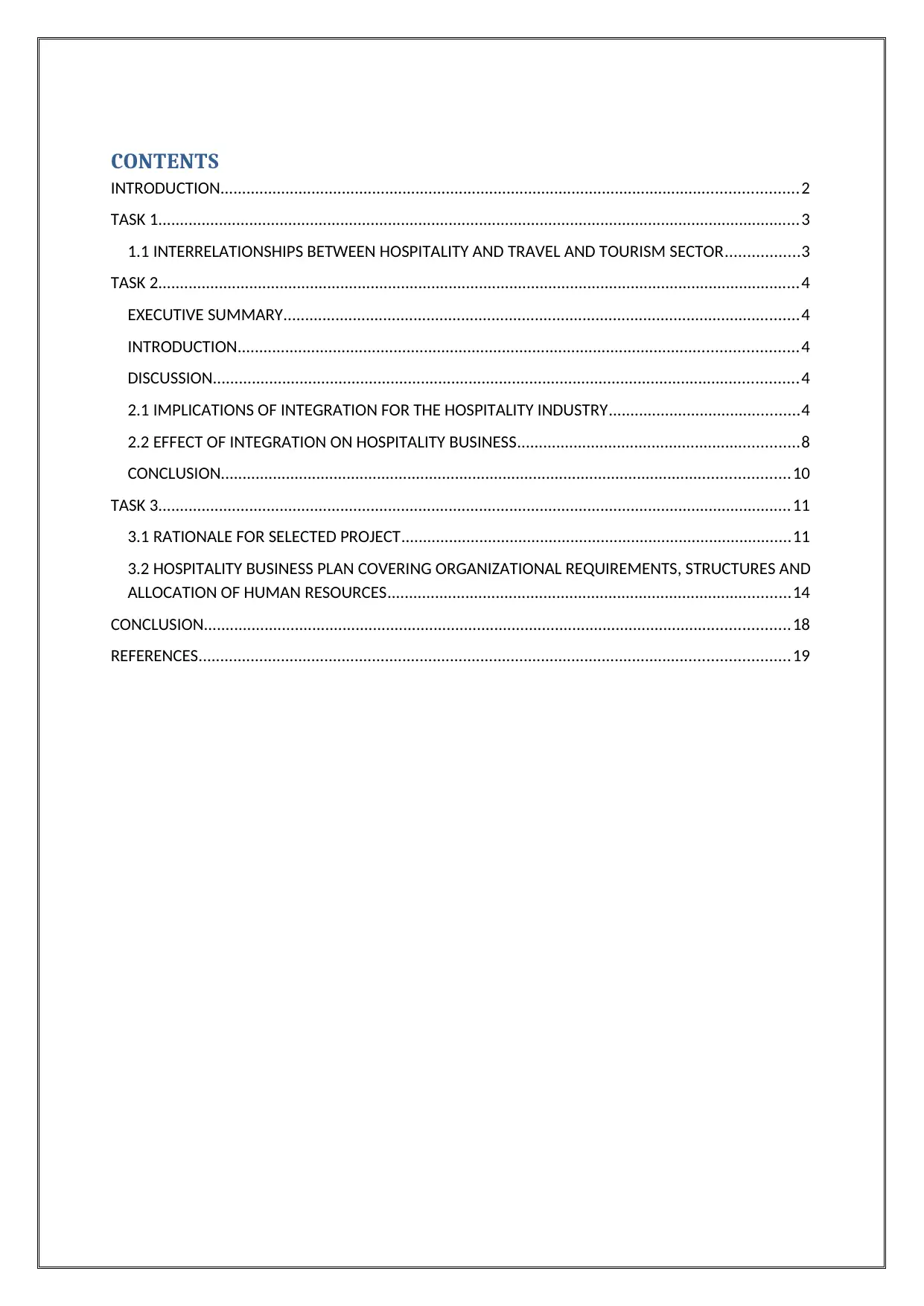
CONTENTS
INTRODUCTION.....................................................................................................................................2
TASK 1....................................................................................................................................................3
1.1 INTERRELATIONSHIPS BETWEEN HOSPITALITY AND TRAVEL AND TOURISM SECTOR.................3
TASK 2....................................................................................................................................................4
EXECUTIVE SUMMARY.......................................................................................................................4
INTRODUCTION.................................................................................................................................4
DISCUSSION.......................................................................................................................................4
2.1 IMPLICATIONS OF INTEGRATION FOR THE HOSPITALITY INDUSTRY............................................4
2.2 EFFECT OF INTEGRATION ON HOSPITALITY BUSINESS.................................................................8
CONCLUSION...................................................................................................................................10
TASK 3..................................................................................................................................................11
3.1 RATIONALE FOR SELECTED PROJECT..........................................................................................11
3.2 HOSPITALITY BUSINESS PLAN COVERING ORGANIZATIONAL REQUIREMENTS, STRUCTURES AND
ALLOCATION OF HUMAN RESOURCES.............................................................................................14
CONCLUSION.......................................................................................................................................18
REFERENCES........................................................................................................................................19
INTRODUCTION.....................................................................................................................................2
TASK 1....................................................................................................................................................3
1.1 INTERRELATIONSHIPS BETWEEN HOSPITALITY AND TRAVEL AND TOURISM SECTOR.................3
TASK 2....................................................................................................................................................4
EXECUTIVE SUMMARY.......................................................................................................................4
INTRODUCTION.................................................................................................................................4
DISCUSSION.......................................................................................................................................4
2.1 IMPLICATIONS OF INTEGRATION FOR THE HOSPITALITY INDUSTRY............................................4
2.2 EFFECT OF INTEGRATION ON HOSPITALITY BUSINESS.................................................................8
CONCLUSION...................................................................................................................................10
TASK 3..................................................................................................................................................11
3.1 RATIONALE FOR SELECTED PROJECT..........................................................................................11
3.2 HOSPITALITY BUSINESS PLAN COVERING ORGANIZATIONAL REQUIREMENTS, STRUCTURES AND
ALLOCATION OF HUMAN RESOURCES.............................................................................................14
CONCLUSION.......................................................................................................................................18
REFERENCES........................................................................................................................................19
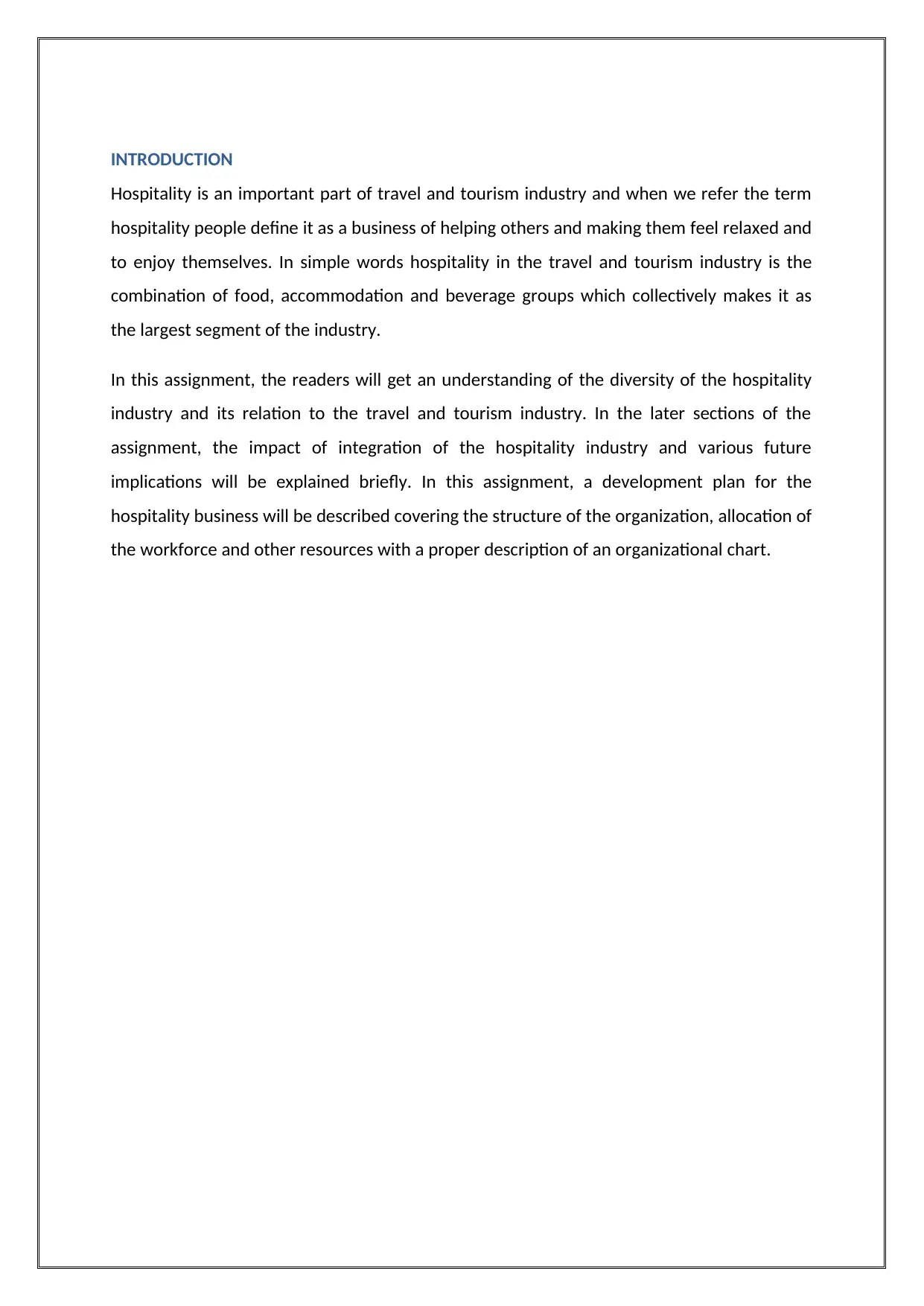
INTRODUCTION
Hospitality is an important part of travel and tourism industry and when we refer the term
hospitality people define it as a business of helping others and making them feel relaxed and
to enjoy themselves. In simple words hospitality in the travel and tourism industry is the
combination of food, accommodation and beverage groups which collectively makes it as
the largest segment of the industry.
In this assignment, the readers will get an understanding of the diversity of the hospitality
industry and its relation to the travel and tourism industry. In the later sections of the
assignment, the impact of integration of the hospitality industry and various future
implications will be explained briefly. In this assignment, a development plan for the
hospitality business will be described covering the structure of the organization, allocation of
the workforce and other resources with a proper description of an organizational chart.
Hospitality is an important part of travel and tourism industry and when we refer the term
hospitality people define it as a business of helping others and making them feel relaxed and
to enjoy themselves. In simple words hospitality in the travel and tourism industry is the
combination of food, accommodation and beverage groups which collectively makes it as
the largest segment of the industry.
In this assignment, the readers will get an understanding of the diversity of the hospitality
industry and its relation to the travel and tourism industry. In the later sections of the
assignment, the impact of integration of the hospitality industry and various future
implications will be explained briefly. In this assignment, a development plan for the
hospitality business will be described covering the structure of the organization, allocation of
the workforce and other resources with a proper description of an organizational chart.
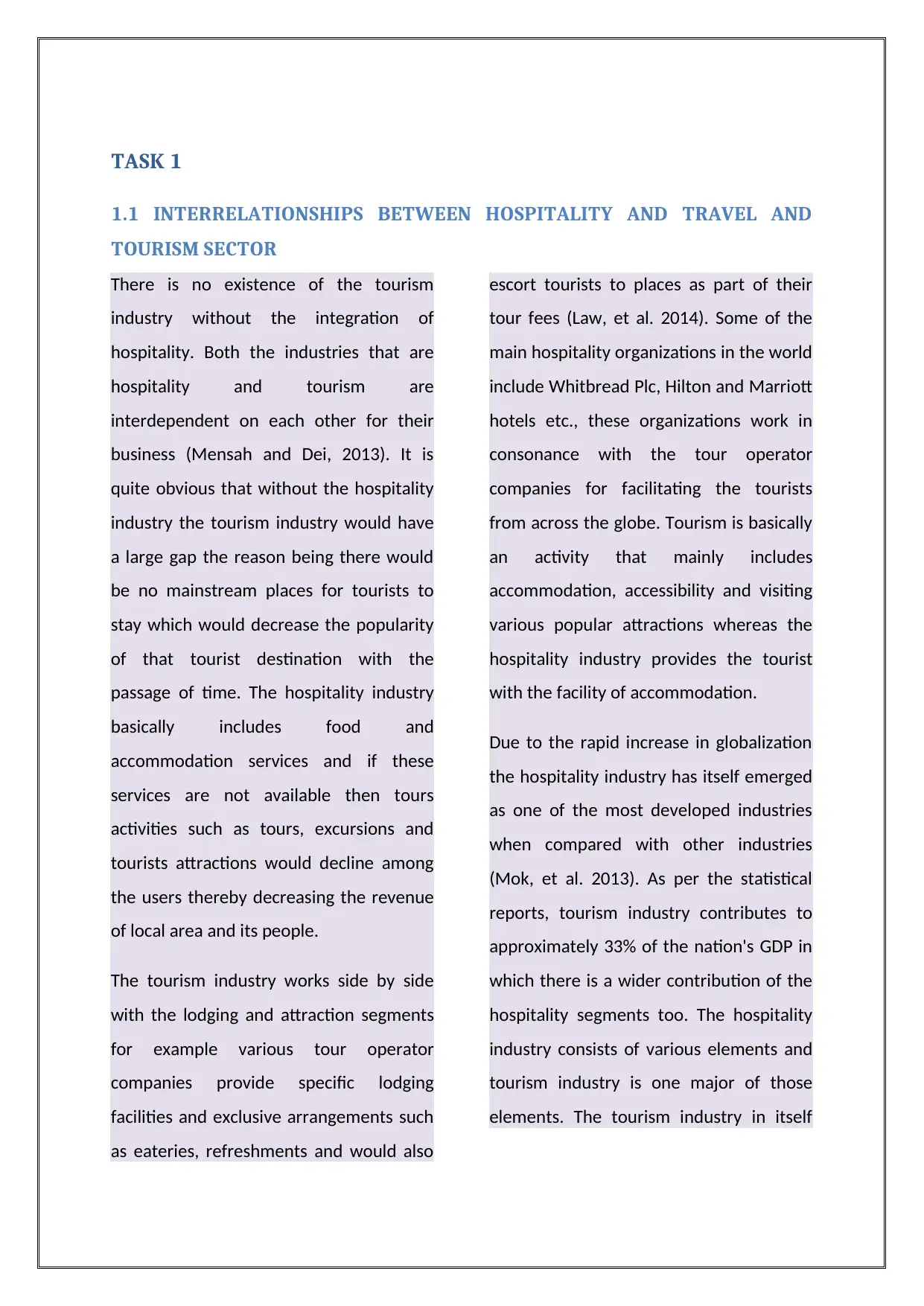
TASK 1
1.1 INTERRELATIONSHIPS BETWEEN HOSPITALITY AND TRAVEL AND
TOURISM SECTOR
There is no existence of the tourism
industry without the integration of
hospitality. Both the industries that are
hospitality and tourism are
interdependent on each other for their
business (Mensah and Dei, 2013). It is
quite obvious that without the hospitality
industry the tourism industry would have
a large gap the reason being there would
be no mainstream places for tourists to
stay which would decrease the popularity
of that tourist destination with the
passage of time. The hospitality industry
basically includes food and
accommodation services and if these
services are not available then tours
activities such as tours, excursions and
tourists attractions would decline among
the users thereby decreasing the revenue
of local area and its people.
The tourism industry works side by side
with the lodging and attraction segments
for example various tour operator
companies provide specific lodging
facilities and exclusive arrangements such
as eateries, refreshments and would also
escort tourists to places as part of their
tour fees (Law, et al. 2014). Some of the
main hospitality organizations in the world
include Whitbread Plc, Hilton and Marriott
hotels etc., these organizations work in
consonance with the tour operator
companies for facilitating the tourists
from across the globe. Tourism is basically
an activity that mainly includes
accommodation, accessibility and visiting
various popular attractions whereas the
hospitality industry provides the tourist
with the facility of accommodation.
Due to the rapid increase in globalization
the hospitality industry has itself emerged
as one of the most developed industries
when compared with other industries
(Mok, et al. 2013). As per the statistical
reports, tourism industry contributes to
approximately 33% of the nation's GDP in
which there is a wider contribution of the
hospitality segments too. The hospitality
industry consists of various elements and
tourism industry is one major of those
elements. The tourism industry in itself
1.1 INTERRELATIONSHIPS BETWEEN HOSPITALITY AND TRAVEL AND
TOURISM SECTOR
There is no existence of the tourism
industry without the integration of
hospitality. Both the industries that are
hospitality and tourism are
interdependent on each other for their
business (Mensah and Dei, 2013). It is
quite obvious that without the hospitality
industry the tourism industry would have
a large gap the reason being there would
be no mainstream places for tourists to
stay which would decrease the popularity
of that tourist destination with the
passage of time. The hospitality industry
basically includes food and
accommodation services and if these
services are not available then tours
activities such as tours, excursions and
tourists attractions would decline among
the users thereby decreasing the revenue
of local area and its people.
The tourism industry works side by side
with the lodging and attraction segments
for example various tour operator
companies provide specific lodging
facilities and exclusive arrangements such
as eateries, refreshments and would also
escort tourists to places as part of their
tour fees (Law, et al. 2014). Some of the
main hospitality organizations in the world
include Whitbread Plc, Hilton and Marriott
hotels etc., these organizations work in
consonance with the tour operator
companies for facilitating the tourists
from across the globe. Tourism is basically
an activity that mainly includes
accommodation, accessibility and visiting
various popular attractions whereas the
hospitality industry provides the tourist
with the facility of accommodation.
Due to the rapid increase in globalization
the hospitality industry has itself emerged
as one of the most developed industries
when compared with other industries
(Mok, et al. 2013). As per the statistical
reports, tourism industry contributes to
approximately 33% of the nation's GDP in
which there is a wider contribution of the
hospitality segments too. The hospitality
industry consists of various elements and
tourism industry is one major of those
elements. The tourism industry in itself
Secure Best Marks with AI Grader
Need help grading? Try our AI Grader for instant feedback on your assignments.

constitutes the progress of farmhouses,
motels, guesthouses, villas, parks etc.
COMPOSITION OF HOSPITALITY
INDUSTRY
In the travel and tourism industry tourists
from around the world make use of
variables from the hospitality industry and
these variables are briefly described below
(Barrows, et al. 2012).
Hotels
The type of a hotel is determined by its
size and location. A hotel is also classified
by its function and target market,
amenities, standards and service level. A
hotel is classified into various types of
variables such as the number of guest
rooms, sizes of rooms like a small
boutique or a large hall with thousands of
rooms (Farrou, et al. 2012). The services
provided by the hotel are also a key such
as inexpensive, costly or budget friendly.
There can be some extra facilities within
the hotel such as a place for vehicle
parking, spas, gym, golf courses etc. The
type of ownership is also an important
variable as there are many independent
owners, third party owners or franchised
hotels. For example, there are 19 different
hotel brands of Hilton and Marriott having
a separate name for each brand and
offering different prices and services to
the customers. Moreover, there are many
industry organizations like the Trip advisor
or AAA who provide consumer ratings for
individual hotels.
Restaurants and Night Clubs
A restaurant is a part of the hospitality
industry for the tourists or guests where
people visit the restaurants for sitting and
eating meals being cooked or served at
the premises (Zomerdijk and Voss, 2010).
A nightclub is a place of entertainment
and fun but it should not be misjudged as
being a bar as nightclubs have an inclusion
of music and dance where a DJ plays
recorded music.
Pubs and Bars
Pubs or a bar is a place where people
come for consuming beer or other drinks
and sometimes food as a part of leisure
and a fun activity (Brotherton, 2012).
Contract food service providers
The food service providers have an
agreement with their clients and the meal
providers. The clients of the food service
providers could be anyone for example
school, private individuals or public
entities.
Hospitality Services
motels, guesthouses, villas, parks etc.
COMPOSITION OF HOSPITALITY
INDUSTRY
In the travel and tourism industry tourists
from around the world make use of
variables from the hospitality industry and
these variables are briefly described below
(Barrows, et al. 2012).
Hotels
The type of a hotel is determined by its
size and location. A hotel is also classified
by its function and target market,
amenities, standards and service level. A
hotel is classified into various types of
variables such as the number of guest
rooms, sizes of rooms like a small
boutique or a large hall with thousands of
rooms (Farrou, et al. 2012). The services
provided by the hotel are also a key such
as inexpensive, costly or budget friendly.
There can be some extra facilities within
the hotel such as a place for vehicle
parking, spas, gym, golf courses etc. The
type of ownership is also an important
variable as there are many independent
owners, third party owners or franchised
hotels. For example, there are 19 different
hotel brands of Hilton and Marriott having
a separate name for each brand and
offering different prices and services to
the customers. Moreover, there are many
industry organizations like the Trip advisor
or AAA who provide consumer ratings for
individual hotels.
Restaurants and Night Clubs
A restaurant is a part of the hospitality
industry for the tourists or guests where
people visit the restaurants for sitting and
eating meals being cooked or served at
the premises (Zomerdijk and Voss, 2010).
A nightclub is a place of entertainment
and fun but it should not be misjudged as
being a bar as nightclubs have an inclusion
of music and dance where a DJ plays
recorded music.
Pubs and Bars
Pubs or a bar is a place where people
come for consuming beer or other drinks
and sometimes food as a part of leisure
and a fun activity (Brotherton, 2012).
Contract food service providers
The food service providers have an
agreement with their clients and the meal
providers. The clients of the food service
providers could be anyone for example
school, private individuals or public
entities.
Hospitality Services
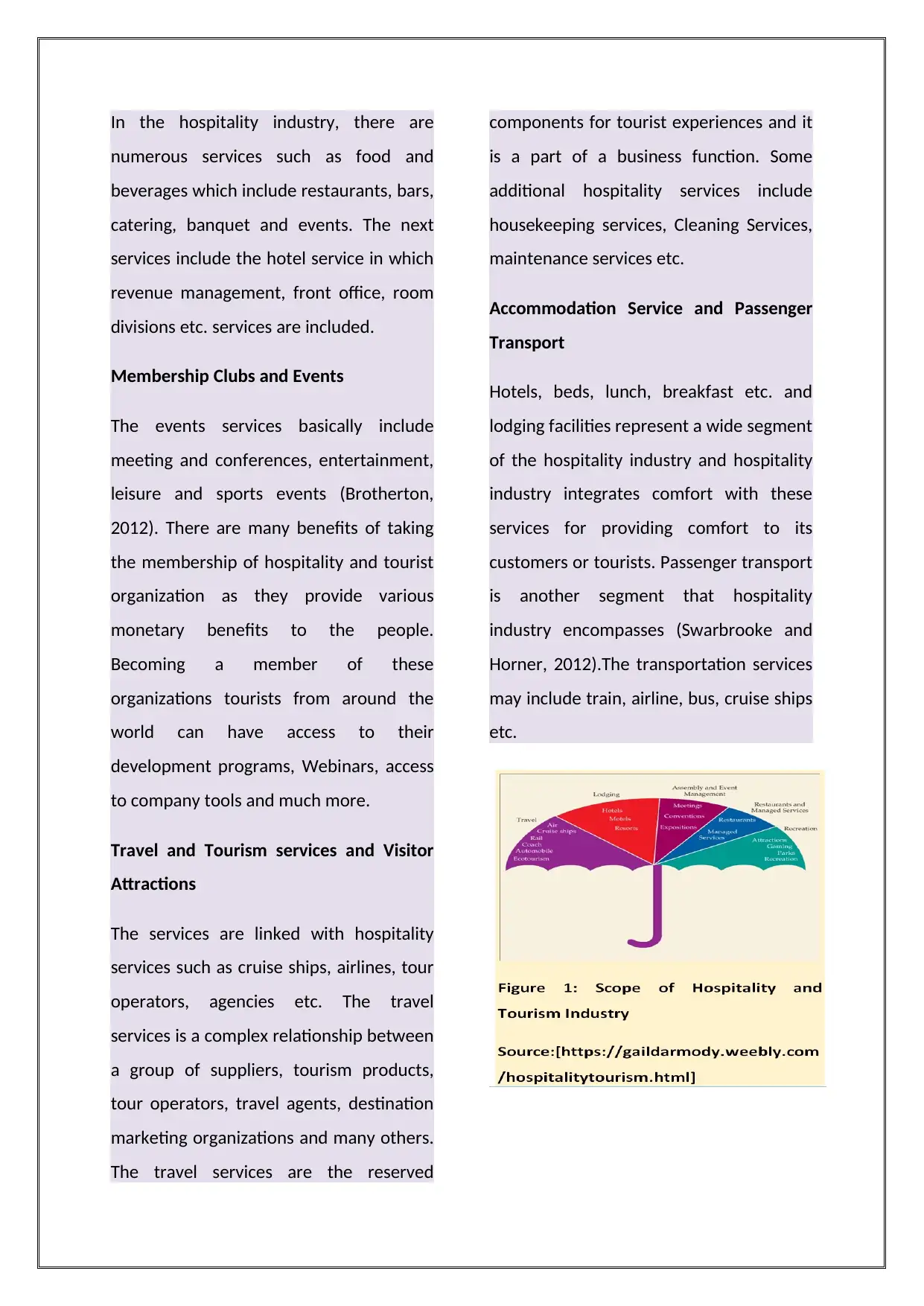
In the hospitality industry, there are
numerous services such as food and
beverages which include restaurants, bars,
catering, banquet and events. The next
services include the hotel service in which
revenue management, front office, room
divisions etc. services are included.
Membership Clubs and Events
The events services basically include
meeting and conferences, entertainment,
leisure and sports events (Brotherton,
2012). There are many benefits of taking
the membership of hospitality and tourist
organization as they provide various
monetary benefits to the people.
Becoming a member of these
organizations tourists from around the
world can have access to their
development programs, Webinars, access
to company tools and much more.
Travel and Tourism services and Visitor
Attractions
The services are linked with hospitality
services such as cruise ships, airlines, tour
operators, agencies etc. The travel
services is a complex relationship between
a group of suppliers, tourism products,
tour operators, travel agents, destination
marketing organizations and many others.
The travel services are the reserved
components for tourist experiences and it
is a part of a business function. Some
additional hospitality services include
housekeeping services, Cleaning Services,
maintenance services etc.
Accommodation Service and Passenger
Transport
Hotels, beds, lunch, breakfast etc. and
lodging facilities represent a wide segment
of the hospitality industry and hospitality
industry integrates comfort with these
services for providing comfort to its
customers or tourists. Passenger transport
is another segment that hospitality
industry encompasses (Swarbrooke and
Horner, 2012).The transportation services
may include train, airline, bus, cruise ships
etc.
numerous services such as food and
beverages which include restaurants, bars,
catering, banquet and events. The next
services include the hotel service in which
revenue management, front office, room
divisions etc. services are included.
Membership Clubs and Events
The events services basically include
meeting and conferences, entertainment,
leisure and sports events (Brotherton,
2012). There are many benefits of taking
the membership of hospitality and tourist
organization as they provide various
monetary benefits to the people.
Becoming a member of these
organizations tourists from around the
world can have access to their
development programs, Webinars, access
to company tools and much more.
Travel and Tourism services and Visitor
Attractions
The services are linked with hospitality
services such as cruise ships, airlines, tour
operators, agencies etc. The travel
services is a complex relationship between
a group of suppliers, tourism products,
tour operators, travel agents, destination
marketing organizations and many others.
The travel services are the reserved
components for tourist experiences and it
is a part of a business function. Some
additional hospitality services include
housekeeping services, Cleaning Services,
maintenance services etc.
Accommodation Service and Passenger
Transport
Hotels, beds, lunch, breakfast etc. and
lodging facilities represent a wide segment
of the hospitality industry and hospitality
industry integrates comfort with these
services for providing comfort to its
customers or tourists. Passenger transport
is another segment that hospitality
industry encompasses (Swarbrooke and
Horner, 2012).The transportation services
may include train, airline, bus, cruise ships
etc.
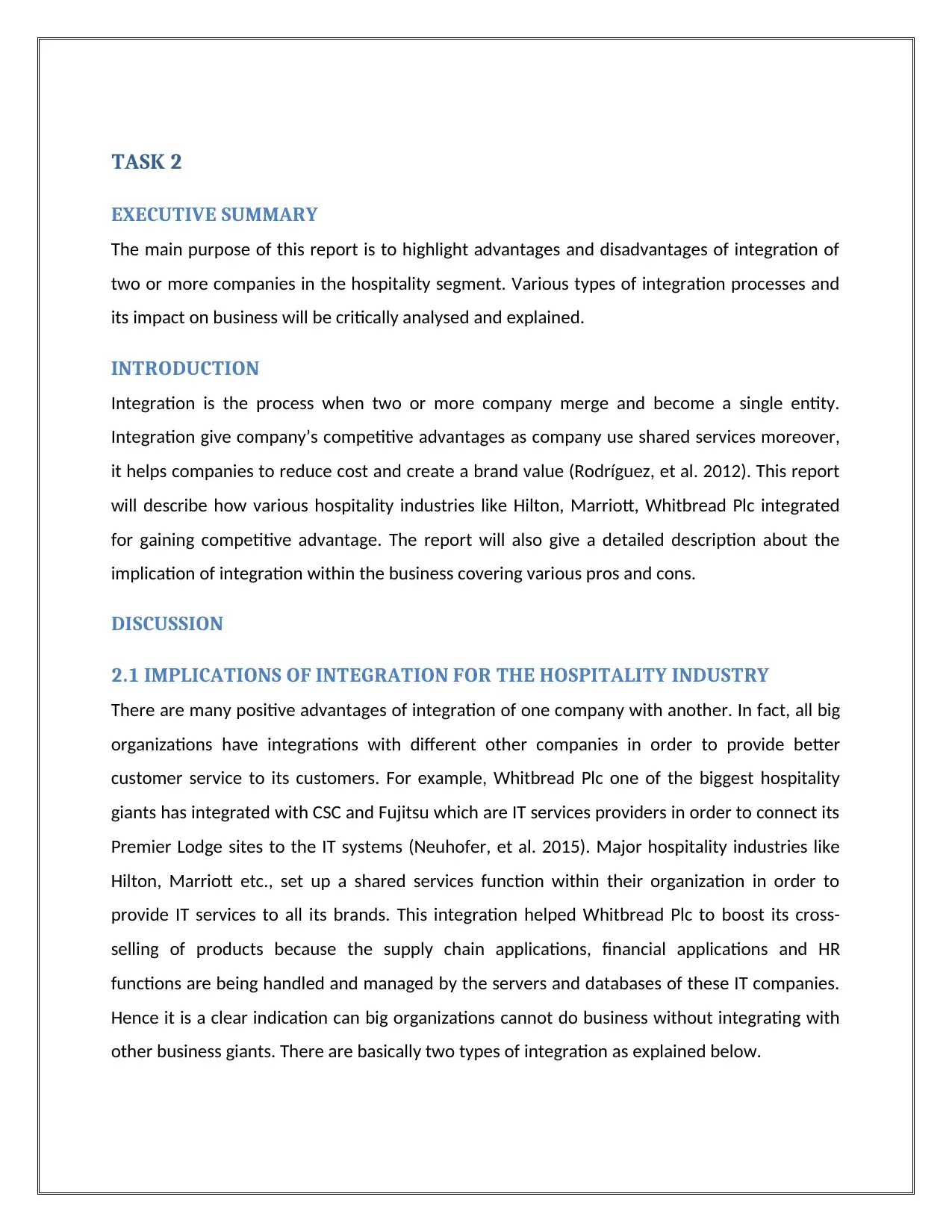
TASK 2
EXECUTIVE SUMMARY
The main purpose of this report is to highlight advantages and disadvantages of integration of
two or more companies in the hospitality segment. Various types of integration processes and
its impact on business will be critically analysed and explained.
INTRODUCTION
Integration is the process when two or more company merge and become a single entity.
Integration give company’s competitive advantages as company use shared services moreover,
it helps companies to reduce cost and create a brand value (Rodríguez, et al. 2012). This report
will describe how various hospitality industries like Hilton, Marriott, Whitbread Plc integrated
for gaining competitive advantage. The report will also give a detailed description about the
implication of integration within the business covering various pros and cons.
DISCUSSION
2.1 IMPLICATIONS OF INTEGRATION FOR THE HOSPITALITY INDUSTRY
There are many positive advantages of integration of one company with another. In fact, all big
organizations have integrations with different other companies in order to provide better
customer service to its customers. For example, Whitbread Plc one of the biggest hospitality
giants has integrated with CSC and Fujitsu which are IT services providers in order to connect its
Premier Lodge sites to the IT systems (Neuhofer, et al. 2015). Major hospitality industries like
Hilton, Marriott etc., set up a shared services function within their organization in order to
provide IT services to all its brands. This integration helped Whitbread Plc to boost its cross-
selling of products because the supply chain applications, financial applications and HR
functions are being handled and managed by the servers and databases of these IT companies.
Hence it is a clear indication can big organizations cannot do business without integrating with
other business giants. There are basically two types of integration as explained below.
EXECUTIVE SUMMARY
The main purpose of this report is to highlight advantages and disadvantages of integration of
two or more companies in the hospitality segment. Various types of integration processes and
its impact on business will be critically analysed and explained.
INTRODUCTION
Integration is the process when two or more company merge and become a single entity.
Integration give company’s competitive advantages as company use shared services moreover,
it helps companies to reduce cost and create a brand value (Rodríguez, et al. 2012). This report
will describe how various hospitality industries like Hilton, Marriott, Whitbread Plc integrated
for gaining competitive advantage. The report will also give a detailed description about the
implication of integration within the business covering various pros and cons.
DISCUSSION
2.1 IMPLICATIONS OF INTEGRATION FOR THE HOSPITALITY INDUSTRY
There are many positive advantages of integration of one company with another. In fact, all big
organizations have integrations with different other companies in order to provide better
customer service to its customers. For example, Whitbread Plc one of the biggest hospitality
giants has integrated with CSC and Fujitsu which are IT services providers in order to connect its
Premier Lodge sites to the IT systems (Neuhofer, et al. 2015). Major hospitality industries like
Hilton, Marriott etc., set up a shared services function within their organization in order to
provide IT services to all its brands. This integration helped Whitbread Plc to boost its cross-
selling of products because the supply chain applications, financial applications and HR
functions are being handled and managed by the servers and databases of these IT companies.
Hence it is a clear indication can big organizations cannot do business without integrating with
other business giants. There are basically two types of integration as explained below.
Paraphrase This Document
Need a fresh take? Get an instant paraphrase of this document with our AI Paraphraser
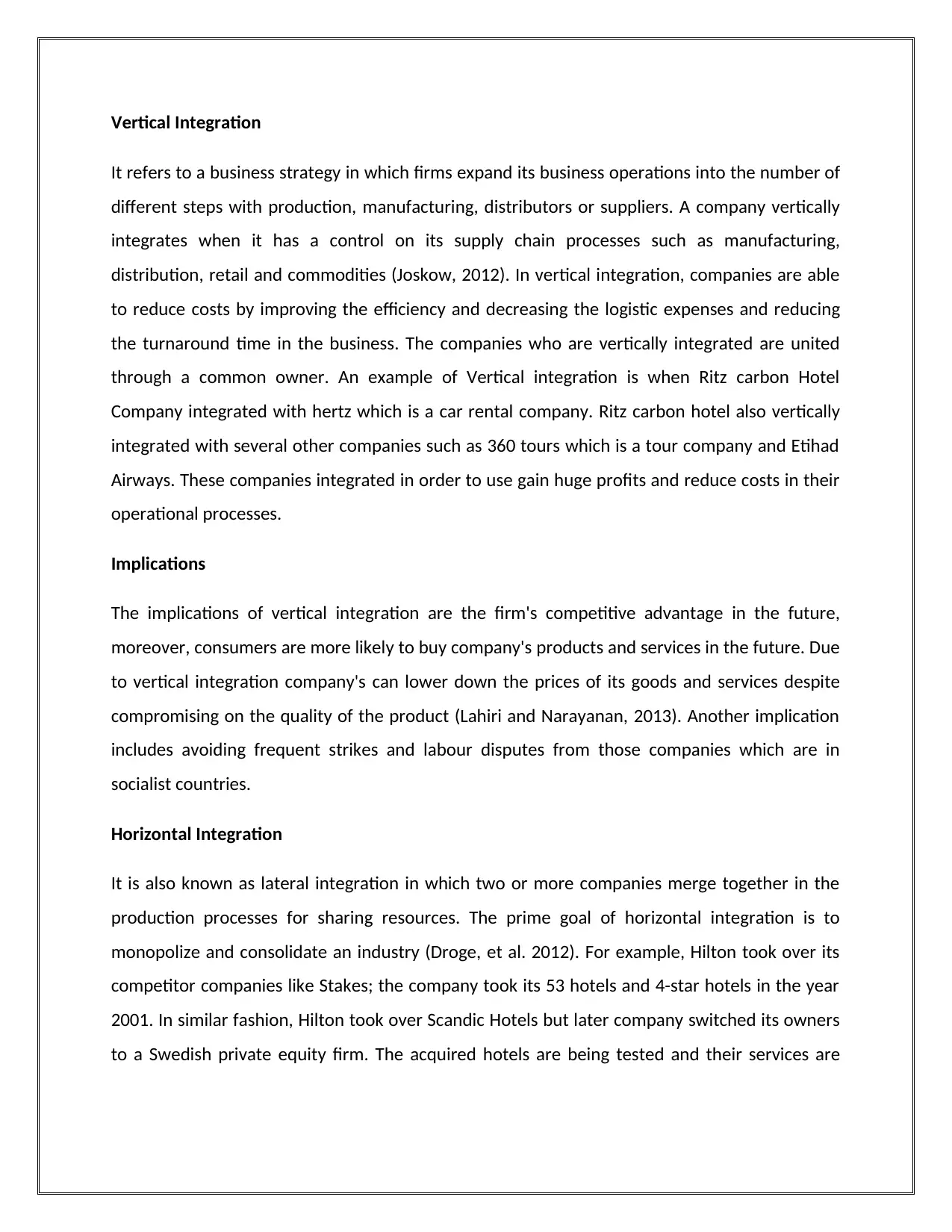
Vertical Integration
It refers to a business strategy in which firms expand its business operations into the number of
different steps with production, manufacturing, distributors or suppliers. A company vertically
integrates when it has a control on its supply chain processes such as manufacturing,
distribution, retail and commodities (Joskow, 2012). In vertical integration, companies are able
to reduce costs by improving the efficiency and decreasing the logistic expenses and reducing
the turnaround time in the business. The companies who are vertically integrated are united
through a common owner. An example of Vertical integration is when Ritz carbon Hotel
Company integrated with hertz which is a car rental company. Ritz carbon hotel also vertically
integrated with several other companies such as 360 tours which is a tour company and Etihad
Airways. These companies integrated in order to use gain huge profits and reduce costs in their
operational processes.
Implications
The implications of vertical integration are the firm's competitive advantage in the future,
moreover, consumers are more likely to buy company's products and services in the future. Due
to vertical integration company's can lower down the prices of its goods and services despite
compromising on the quality of the product (Lahiri and Narayanan, 2013). Another implication
includes avoiding frequent strikes and labour disputes from those companies which are in
socialist countries.
Horizontal Integration
It is also known as lateral integration in which two or more companies merge together in the
production processes for sharing resources. The prime goal of horizontal integration is to
monopolize and consolidate an industry (Droge, et al. 2012). For example, Hilton took over its
competitor companies like Stakes; the company took its 53 hotels and 4-star hotels in the year
2001. In similar fashion, Hilton took over Scandic Hotels but later company switched its owners
to a Swedish private equity firm. The acquired hotels are being tested and their services are
It refers to a business strategy in which firms expand its business operations into the number of
different steps with production, manufacturing, distributors or suppliers. A company vertically
integrates when it has a control on its supply chain processes such as manufacturing,
distribution, retail and commodities (Joskow, 2012). In vertical integration, companies are able
to reduce costs by improving the efficiency and decreasing the logistic expenses and reducing
the turnaround time in the business. The companies who are vertically integrated are united
through a common owner. An example of Vertical integration is when Ritz carbon Hotel
Company integrated with hertz which is a car rental company. Ritz carbon hotel also vertically
integrated with several other companies such as 360 tours which is a tour company and Etihad
Airways. These companies integrated in order to use gain huge profits and reduce costs in their
operational processes.
Implications
The implications of vertical integration are the firm's competitive advantage in the future,
moreover, consumers are more likely to buy company's products and services in the future. Due
to vertical integration company's can lower down the prices of its goods and services despite
compromising on the quality of the product (Lahiri and Narayanan, 2013). Another implication
includes avoiding frequent strikes and labour disputes from those companies which are in
socialist countries.
Horizontal Integration
It is also known as lateral integration in which two or more companies merge together in the
production processes for sharing resources. The prime goal of horizontal integration is to
monopolize and consolidate an industry (Droge, et al. 2012). For example, Hilton took over its
competitor companies like Stakes; the company took its 53 hotels and 4-star hotels in the year
2001. In similar fashion, Hilton took over Scandic Hotels but later company switched its owners
to a Swedish private equity firm. The acquired hotels are being tested and their services are
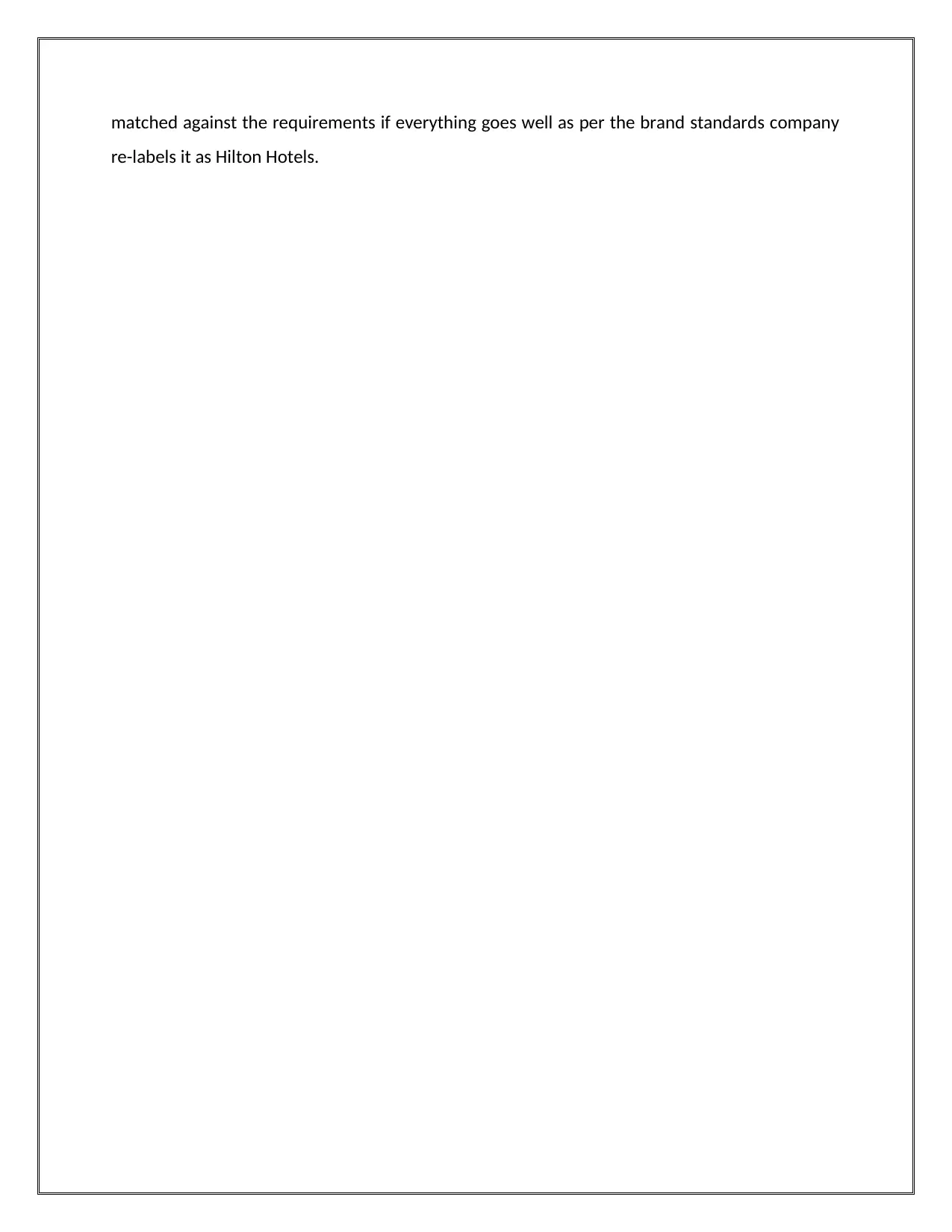
matched against the requirements if everything goes well as per the brand standards company
re-labels it as Hilton Hotels.
re-labels it as Hilton Hotels.
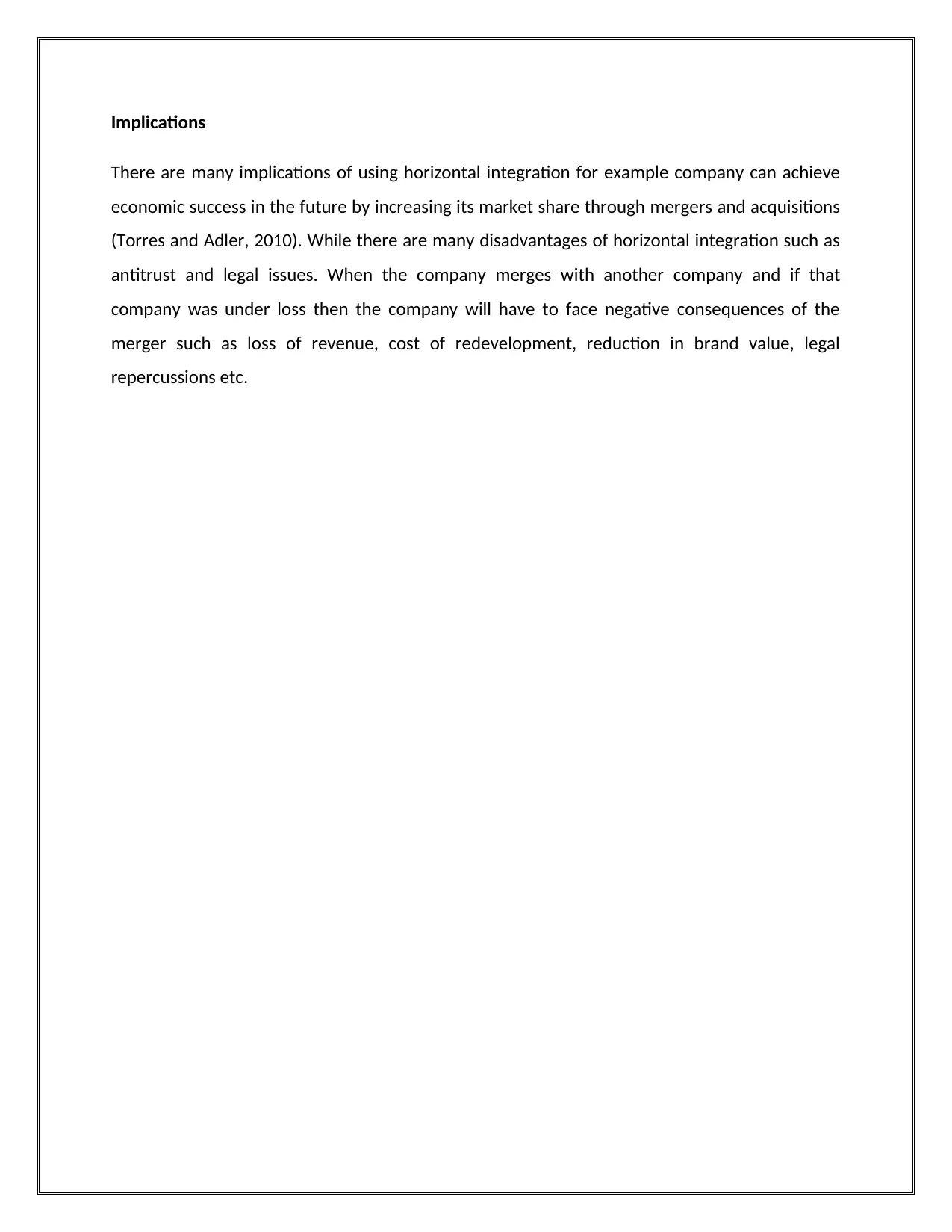
Implications
There are many implications of using horizontal integration for example company can achieve
economic success in the future by increasing its market share through mergers and acquisitions
(Torres and Adler, 2010). While there are many disadvantages of horizontal integration such as
antitrust and legal issues. When the company merges with another company and if that
company was under loss then the company will have to face negative consequences of the
merger such as loss of revenue, cost of redevelopment, reduction in brand value, legal
repercussions etc.
There are many implications of using horizontal integration for example company can achieve
economic success in the future by increasing its market share through mergers and acquisitions
(Torres and Adler, 2010). While there are many disadvantages of horizontal integration such as
antitrust and legal issues. When the company merges with another company and if that
company was under loss then the company will have to face negative consequences of the
merger such as loss of revenue, cost of redevelopment, reduction in brand value, legal
repercussions etc.
Secure Best Marks with AI Grader
Need help grading? Try our AI Grader for instant feedback on your assignments.

2.2 EFFECT OF INTEGRATION ON HOSPITALITY BUSINESS
The hospitality industries like Hilton, Marriott, Whitbread Plc etc. have integrated with many
tour operator companies for running their businesses. Without integration, companies cannot
gain huge profit margins as customers have changing demands which need to be fulfilled
(Damanpour, 2010). The tourist from around the world travel different nations and require
hospitality services like accommodation, lodging facilities, recreational facilitates etc. that can
only be provided by premium hotels which are the part of the hospitality business. It not only
helps companies to expand its business but also create a brand value among consumers.
Let’s consider the case of Marriott hotels which integrated with Starwood hotels and resorts
which have many advantages and disadvantages for both the businesses as described below.
Figure 1: Integration Effects on Hospitality Business
Cost Integration
CostIntegratiGlobalizatioTechnologyQualityStandardizatio
The hospitality industries like Hilton, Marriott, Whitbread Plc etc. have integrated with many
tour operator companies for running their businesses. Without integration, companies cannot
gain huge profit margins as customers have changing demands which need to be fulfilled
(Damanpour, 2010). The tourist from around the world travel different nations and require
hospitality services like accommodation, lodging facilities, recreational facilitates etc. that can
only be provided by premium hotels which are the part of the hospitality business. It not only
helps companies to expand its business but also create a brand value among consumers.
Let’s consider the case of Marriott hotels which integrated with Starwood hotels and resorts
which have many advantages and disadvantages for both the businesses as described below.
Figure 1: Integration Effects on Hospitality Business
Cost Integration
CostIntegratiGlobalizatioTechnologyQualityStandardizatio
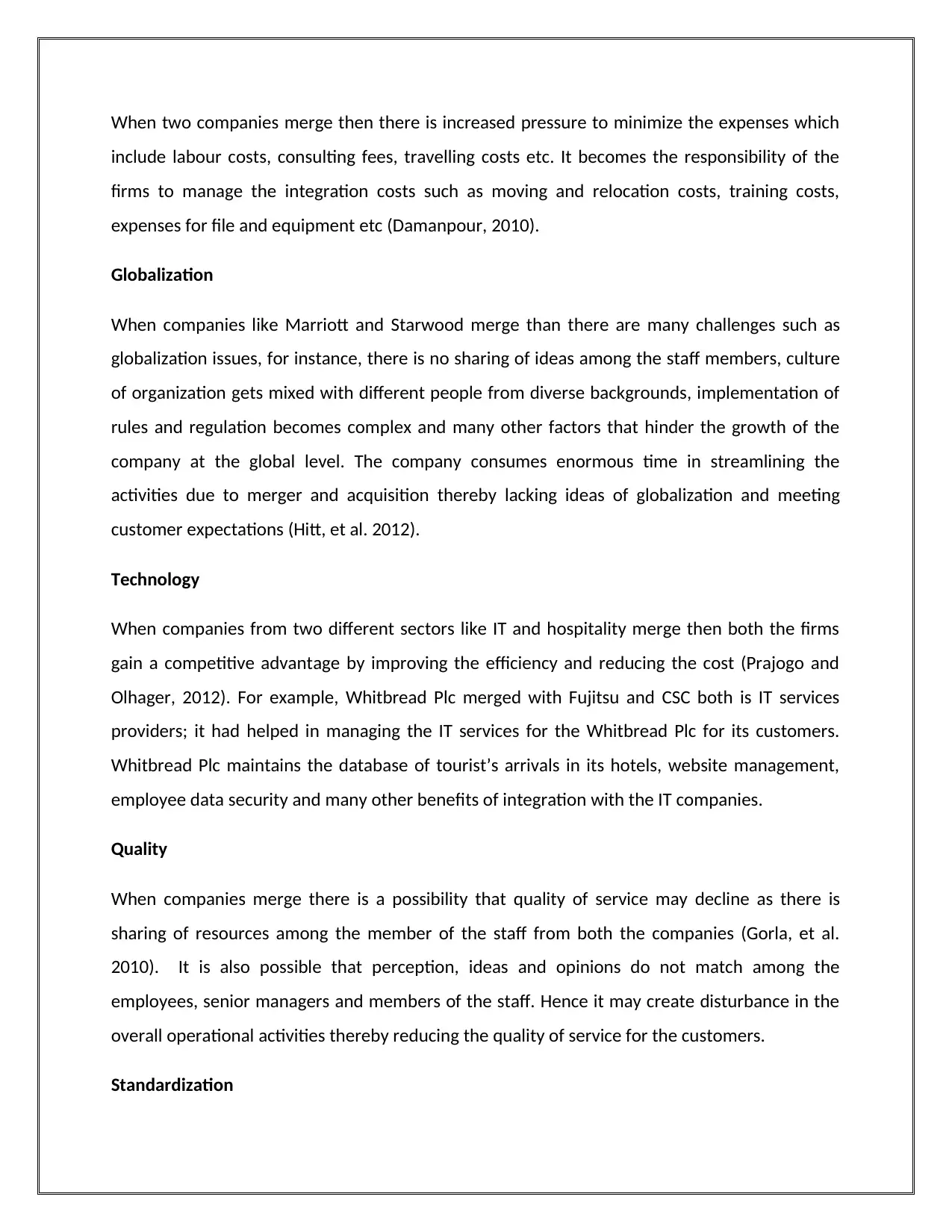
When two companies merge then there is increased pressure to minimize the expenses which
include labour costs, consulting fees, travelling costs etc. It becomes the responsibility of the
firms to manage the integration costs such as moving and relocation costs, training costs,
expenses for file and equipment etc (Damanpour, 2010).
Globalization
When companies like Marriott and Starwood merge than there are many challenges such as
globalization issues, for instance, there is no sharing of ideas among the staff members, culture
of organization gets mixed with different people from diverse backgrounds, implementation of
rules and regulation becomes complex and many other factors that hinder the growth of the
company at the global level. The company consumes enormous time in streamlining the
activities due to merger and acquisition thereby lacking ideas of globalization and meeting
customer expectations (Hitt, et al. 2012).
Technology
When companies from two different sectors like IT and hospitality merge then both the firms
gain a competitive advantage by improving the efficiency and reducing the cost (Prajogo and
Olhager, 2012). For example, Whitbread Plc merged with Fujitsu and CSC both is IT services
providers; it had helped in managing the IT services for the Whitbread Plc for its customers.
Whitbread Plc maintains the database of tourist’s arrivals in its hotels, website management,
employee data security and many other benefits of integration with the IT companies.
Quality
When companies merge there is a possibility that quality of service may decline as there is
sharing of resources among the member of the staff from both the companies (Gorla, et al.
2010). It is also possible that perception, ideas and opinions do not match among the
employees, senior managers and members of the staff. Hence it may create disturbance in the
overall operational activities thereby reducing the quality of service for the customers.
Standardization
include labour costs, consulting fees, travelling costs etc. It becomes the responsibility of the
firms to manage the integration costs such as moving and relocation costs, training costs,
expenses for file and equipment etc (Damanpour, 2010).
Globalization
When companies like Marriott and Starwood merge than there are many challenges such as
globalization issues, for instance, there is no sharing of ideas among the staff members, culture
of organization gets mixed with different people from diverse backgrounds, implementation of
rules and regulation becomes complex and many other factors that hinder the growth of the
company at the global level. The company consumes enormous time in streamlining the
activities due to merger and acquisition thereby lacking ideas of globalization and meeting
customer expectations (Hitt, et al. 2012).
Technology
When companies from two different sectors like IT and hospitality merge then both the firms
gain a competitive advantage by improving the efficiency and reducing the cost (Prajogo and
Olhager, 2012). For example, Whitbread Plc merged with Fujitsu and CSC both is IT services
providers; it had helped in managing the IT services for the Whitbread Plc for its customers.
Whitbread Plc maintains the database of tourist’s arrivals in its hotels, website management,
employee data security and many other benefits of integration with the IT companies.
Quality
When companies merge there is a possibility that quality of service may decline as there is
sharing of resources among the member of the staff from both the companies (Gorla, et al.
2010). It is also possible that perception, ideas and opinions do not match among the
employees, senior managers and members of the staff. Hence it may create disturbance in the
overall operational activities thereby reducing the quality of service for the customers.
Standardization
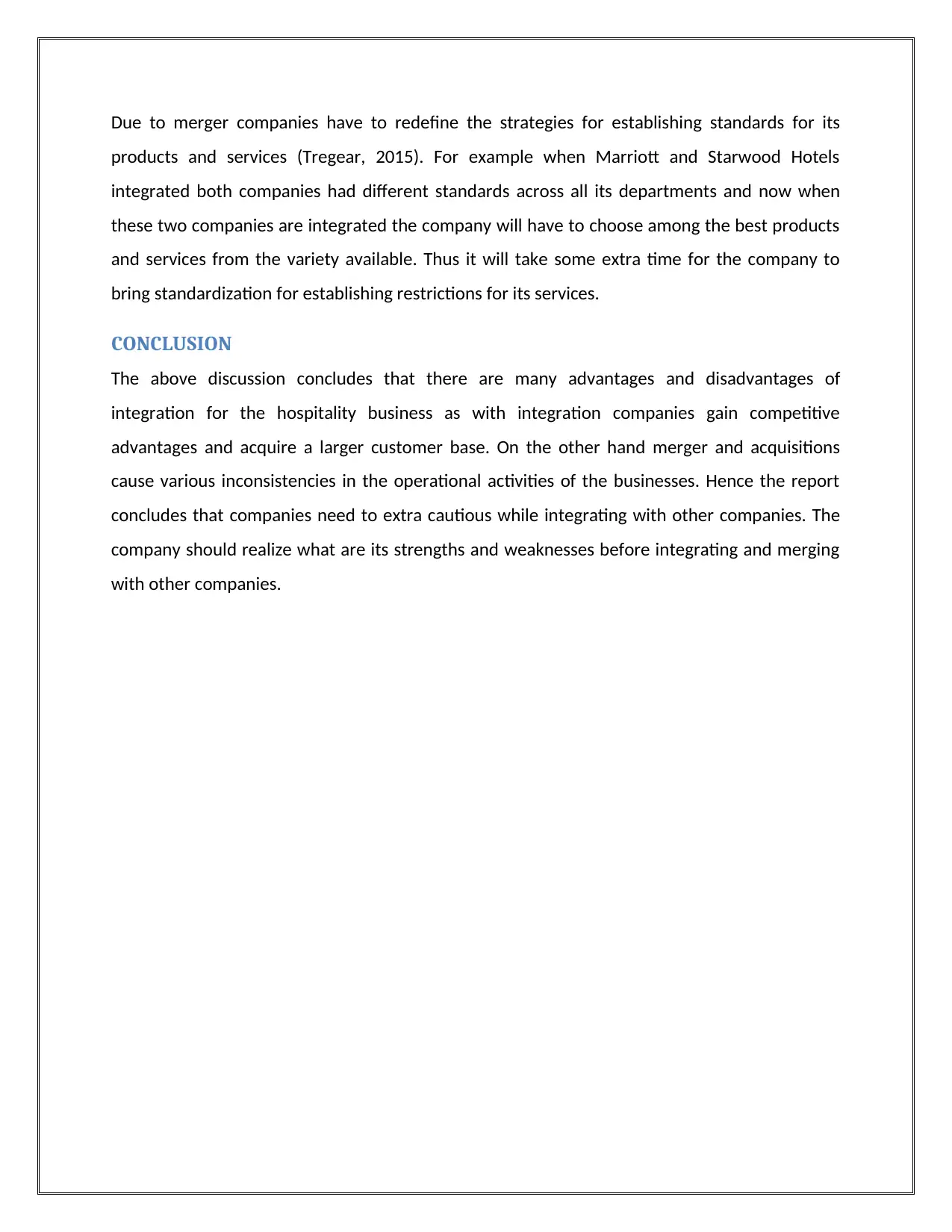
Due to merger companies have to redefine the strategies for establishing standards for its
products and services (Tregear, 2015). For example when Marriott and Starwood Hotels
integrated both companies had different standards across all its departments and now when
these two companies are integrated the company will have to choose among the best products
and services from the variety available. Thus it will take some extra time for the company to
bring standardization for establishing restrictions for its services.
CONCLUSION
The above discussion concludes that there are many advantages and disadvantages of
integration for the hospitality business as with integration companies gain competitive
advantages and acquire a larger customer base. On the other hand merger and acquisitions
cause various inconsistencies in the operational activities of the businesses. Hence the report
concludes that companies need to extra cautious while integrating with other companies. The
company should realize what are its strengths and weaknesses before integrating and merging
with other companies.
products and services (Tregear, 2015). For example when Marriott and Starwood Hotels
integrated both companies had different standards across all its departments and now when
these two companies are integrated the company will have to choose among the best products
and services from the variety available. Thus it will take some extra time for the company to
bring standardization for establishing restrictions for its services.
CONCLUSION
The above discussion concludes that there are many advantages and disadvantages of
integration for the hospitality business as with integration companies gain competitive
advantages and acquire a larger customer base. On the other hand merger and acquisitions
cause various inconsistencies in the operational activities of the businesses. Hence the report
concludes that companies need to extra cautious while integrating with other companies. The
company should realize what are its strengths and weaknesses before integrating and merging
with other companies.
Paraphrase This Document
Need a fresh take? Get an instant paraphrase of this document with our AI Paraphraser
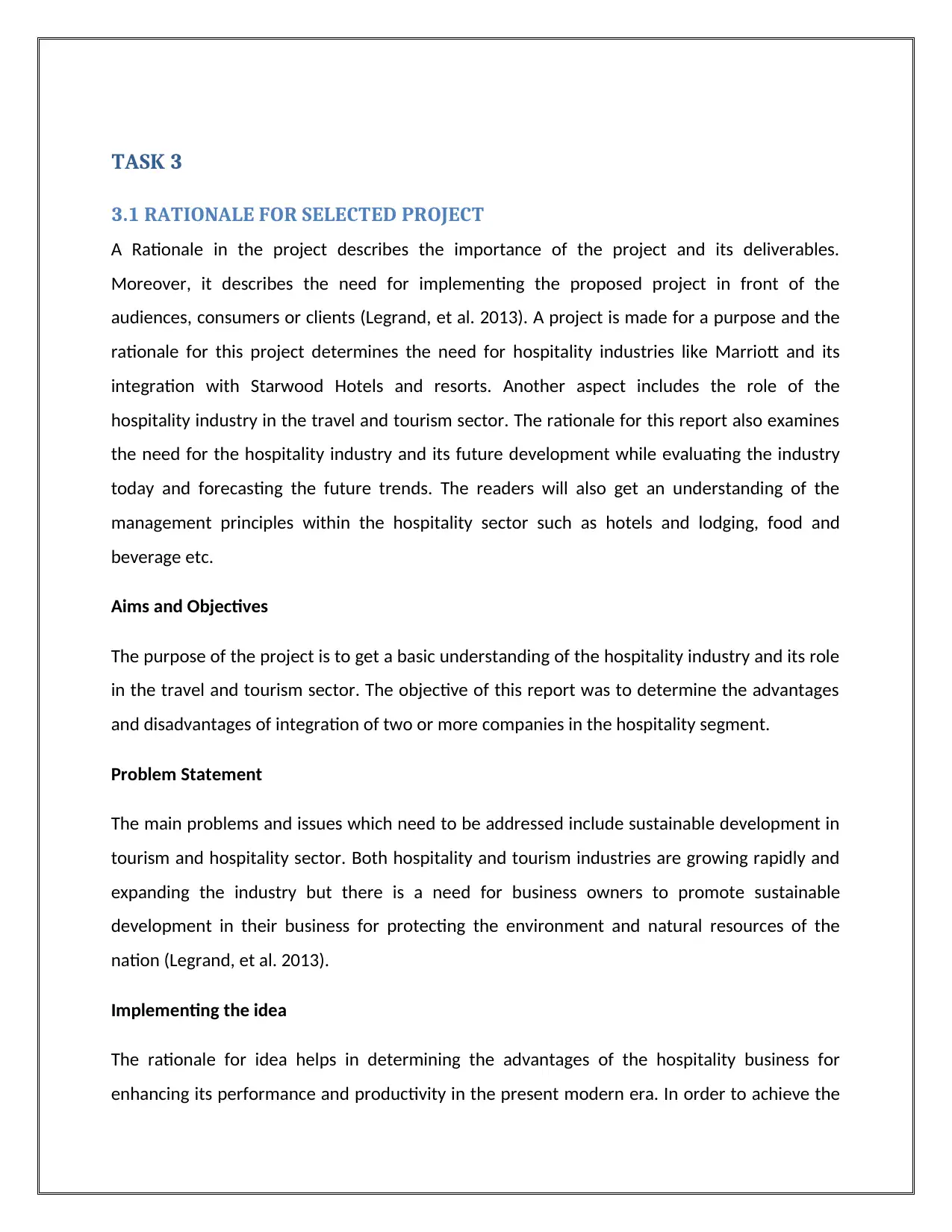
TASK 3
3.1 RATIONALE FOR SELECTED PROJECT
A Rationale in the project describes the importance of the project and its deliverables.
Moreover, it describes the need for implementing the proposed project in front of the
audiences, consumers or clients (Legrand, et al. 2013). A project is made for a purpose and the
rationale for this project determines the need for hospitality industries like Marriott and its
integration with Starwood Hotels and resorts. Another aspect includes the role of the
hospitality industry in the travel and tourism sector. The rationale for this report also examines
the need for the hospitality industry and its future development while evaluating the industry
today and forecasting the future trends. The readers will also get an understanding of the
management principles within the hospitality sector such as hotels and lodging, food and
beverage etc.
Aims and Objectives
The purpose of the project is to get a basic understanding of the hospitality industry and its role
in the travel and tourism sector. The objective of this report was to determine the advantages
and disadvantages of integration of two or more companies in the hospitality segment.
Problem Statement
The main problems and issues which need to be addressed include sustainable development in
tourism and hospitality sector. Both hospitality and tourism industries are growing rapidly and
expanding the industry but there is a need for business owners to promote sustainable
development in their business for protecting the environment and natural resources of the
nation (Legrand, et al. 2013).
Implementing the idea
The rationale for idea helps in determining the advantages of the hospitality business for
enhancing its performance and productivity in the present modern era. In order to achieve the
3.1 RATIONALE FOR SELECTED PROJECT
A Rationale in the project describes the importance of the project and its deliverables.
Moreover, it describes the need for implementing the proposed project in front of the
audiences, consumers or clients (Legrand, et al. 2013). A project is made for a purpose and the
rationale for this project determines the need for hospitality industries like Marriott and its
integration with Starwood Hotels and resorts. Another aspect includes the role of the
hospitality industry in the travel and tourism sector. The rationale for this report also examines
the need for the hospitality industry and its future development while evaluating the industry
today and forecasting the future trends. The readers will also get an understanding of the
management principles within the hospitality sector such as hotels and lodging, food and
beverage etc.
Aims and Objectives
The purpose of the project is to get a basic understanding of the hospitality industry and its role
in the travel and tourism sector. The objective of this report was to determine the advantages
and disadvantages of integration of two or more companies in the hospitality segment.
Problem Statement
The main problems and issues which need to be addressed include sustainable development in
tourism and hospitality sector. Both hospitality and tourism industries are growing rapidly and
expanding the industry but there is a need for business owners to promote sustainable
development in their business for protecting the environment and natural resources of the
nation (Legrand, et al. 2013).
Implementing the idea
The rationale for idea helps in determining the advantages of the hospitality business for
enhancing its performance and productivity in the present modern era. In order to achieve the
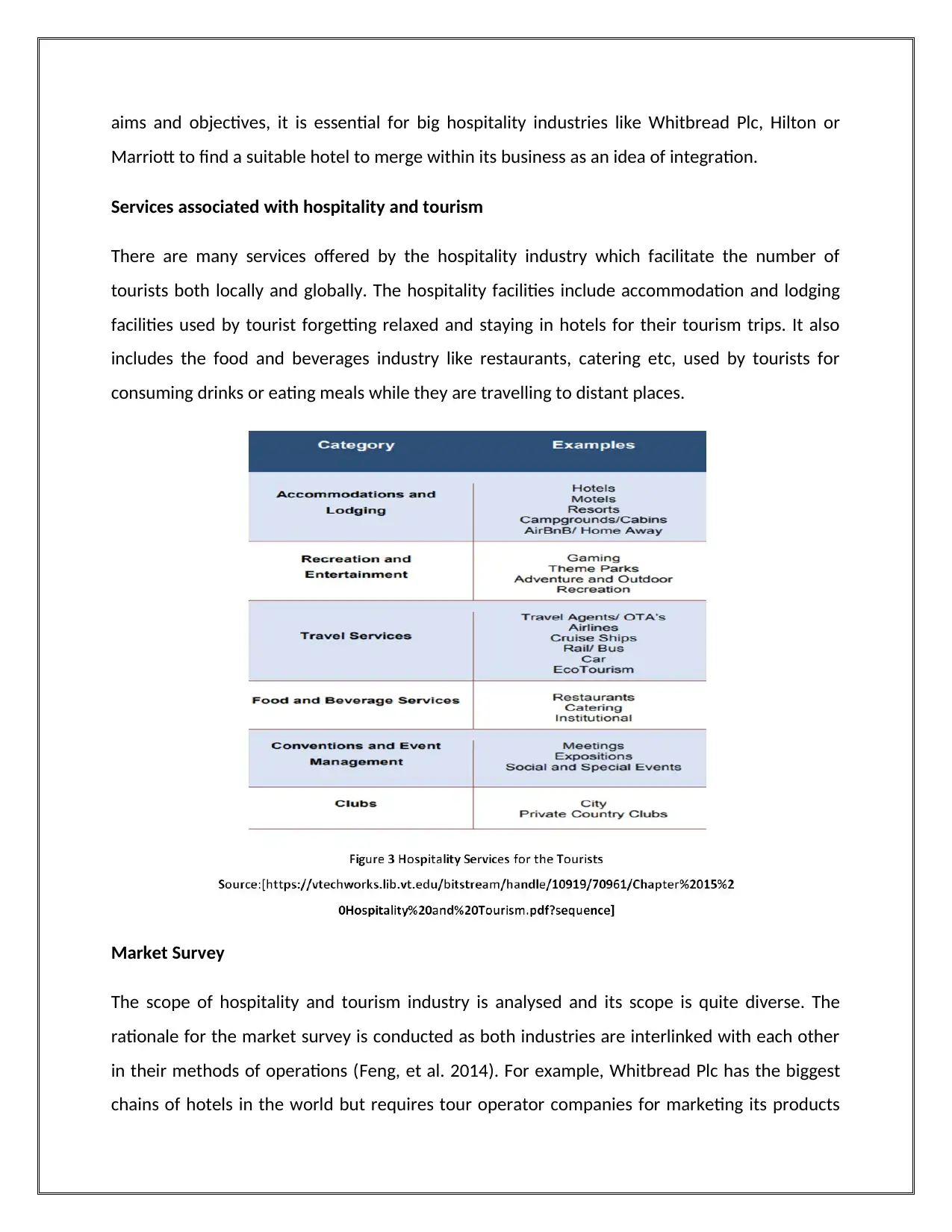
aims and objectives, it is essential for big hospitality industries like Whitbread Plc, Hilton or
Marriott to find a suitable hotel to merge within its business as an idea of integration.
Services associated with hospitality and tourism
There are many services offered by the hospitality industry which facilitate the number of
tourists both locally and globally. The hospitality facilities include accommodation and lodging
facilities used by tourist forgetting relaxed and staying in hotels for their tourism trips. It also
includes the food and beverages industry like restaurants, catering etc, used by tourists for
consuming drinks or eating meals while they are travelling to distant places.
Market Survey
The scope of hospitality and tourism industry is analysed and its scope is quite diverse. The
rationale for the market survey is conducted as both industries are interlinked with each other
in their methods of operations (Feng, et al. 2014). For example, Whitbread Plc has the biggest
chains of hotels in the world but requires tour operator companies for marketing its products
Marriott to find a suitable hotel to merge within its business as an idea of integration.
Services associated with hospitality and tourism
There are many services offered by the hospitality industry which facilitate the number of
tourists both locally and globally. The hospitality facilities include accommodation and lodging
facilities used by tourist forgetting relaxed and staying in hotels for their tourism trips. It also
includes the food and beverages industry like restaurants, catering etc, used by tourists for
consuming drinks or eating meals while they are travelling to distant places.
Market Survey
The scope of hospitality and tourism industry is analysed and its scope is quite diverse. The
rationale for the market survey is conducted as both industries are interlinked with each other
in their methods of operations (Feng, et al. 2014). For example, Whitbread Plc has the biggest
chains of hotels in the world but requires tour operator companies for marketing its products
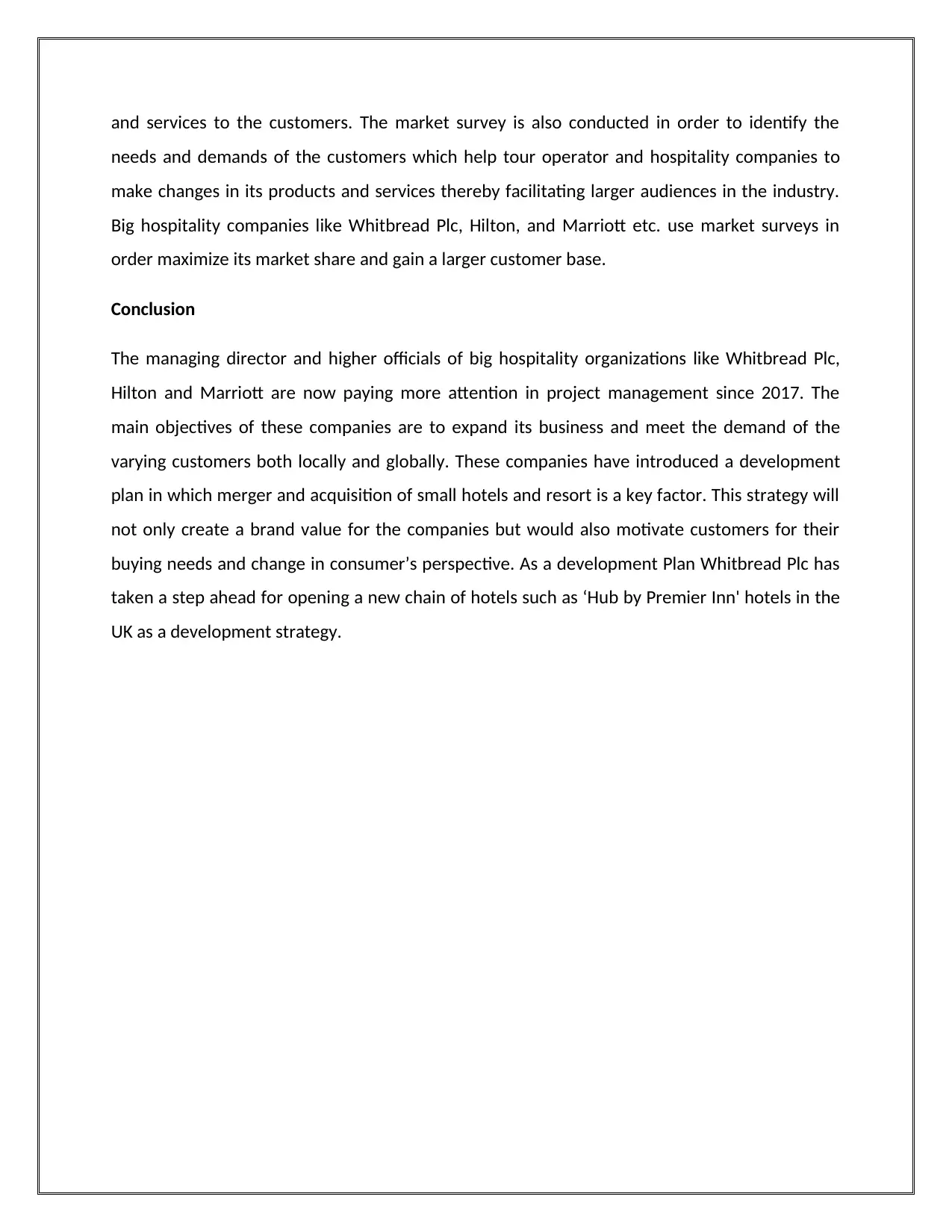
and services to the customers. The market survey is also conducted in order to identify the
needs and demands of the customers which help tour operator and hospitality companies to
make changes in its products and services thereby facilitating larger audiences in the industry.
Big hospitality companies like Whitbread Plc, Hilton, and Marriott etc. use market surveys in
order maximize its market share and gain a larger customer base.
Conclusion
The managing director and higher officials of big hospitality organizations like Whitbread Plc,
Hilton and Marriott are now paying more attention in project management since 2017. The
main objectives of these companies are to expand its business and meet the demand of the
varying customers both locally and globally. These companies have introduced a development
plan in which merger and acquisition of small hotels and resort is a key factor. This strategy will
not only create a brand value for the companies but would also motivate customers for their
buying needs and change in consumer’s perspective. As a development Plan Whitbread Plc has
taken a step ahead for opening a new chain of hotels such as ‘Hub by Premier Inn' hotels in the
UK as a development strategy.
needs and demands of the customers which help tour operator and hospitality companies to
make changes in its products and services thereby facilitating larger audiences in the industry.
Big hospitality companies like Whitbread Plc, Hilton, and Marriott etc. use market surveys in
order maximize its market share and gain a larger customer base.
Conclusion
The managing director and higher officials of big hospitality organizations like Whitbread Plc,
Hilton and Marriott are now paying more attention in project management since 2017. The
main objectives of these companies are to expand its business and meet the demand of the
varying customers both locally and globally. These companies have introduced a development
plan in which merger and acquisition of small hotels and resort is a key factor. This strategy will
not only create a brand value for the companies but would also motivate customers for their
buying needs and change in consumer’s perspective. As a development Plan Whitbread Plc has
taken a step ahead for opening a new chain of hotels such as ‘Hub by Premier Inn' hotels in the
UK as a development strategy.
Secure Best Marks with AI Grader
Need help grading? Try our AI Grader for instant feedback on your assignments.
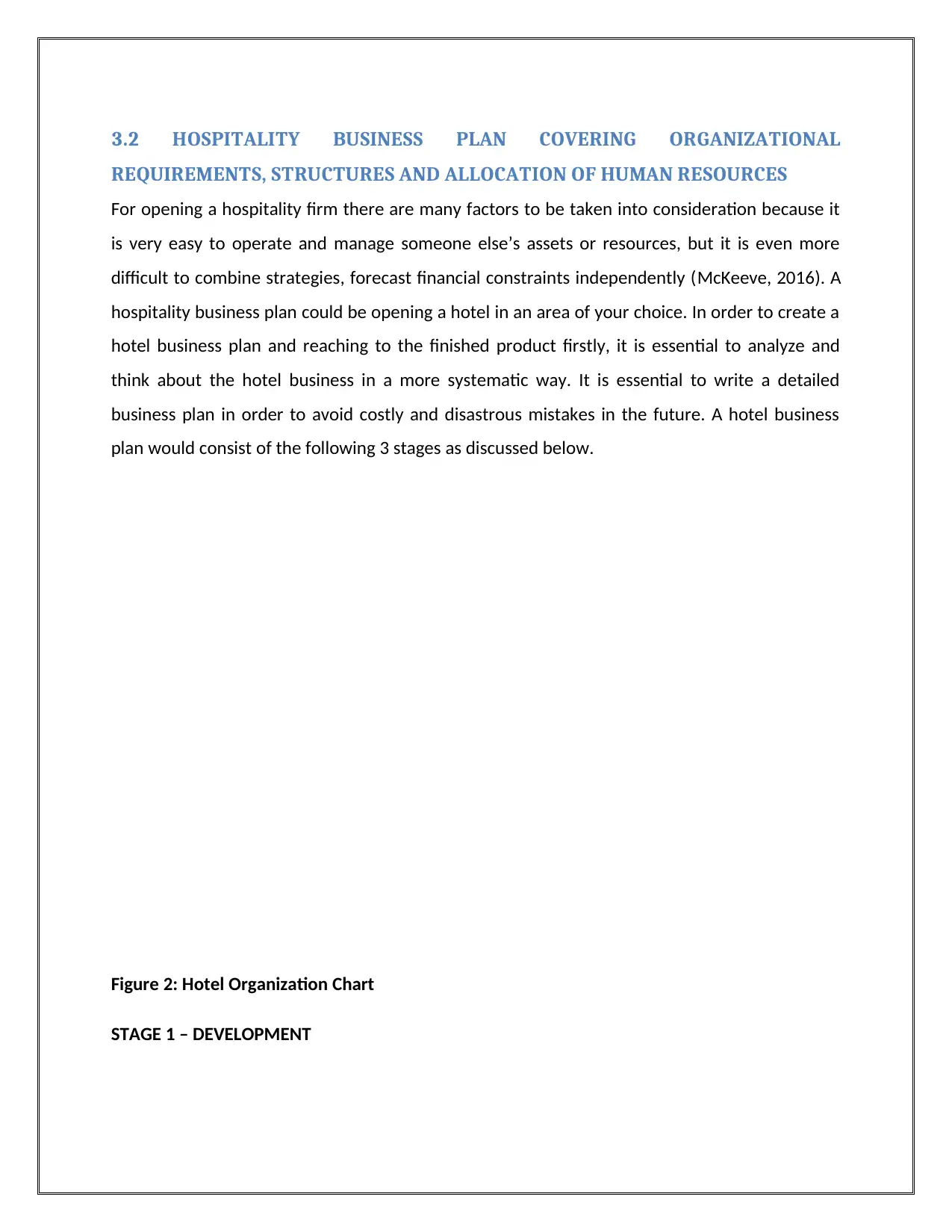
3.2 HOSPITALITY BUSINESS PLAN COVERING ORGANIZATIONAL
REQUIREMENTS, STRUCTURES AND ALLOCATION OF HUMAN RESOURCES
For opening a hospitality firm there are many factors to be taken into consideration because it
is very easy to operate and manage someone else’s assets or resources, but it is even more
difficult to combine strategies, forecast financial constraints independently (McKeeve, 2016). A
hospitality business plan could be opening a hotel in an area of your choice. In order to create a
hotel business plan and reaching to the finished product firstly, it is essential to analyze and
think about the hotel business in a more systematic way. It is essential to write a detailed
business plan in order to avoid costly and disastrous mistakes in the future. A hotel business
plan would consist of the following 3 stages as discussed below.
Figure 2: Hotel Organization Chart
STAGE 1 – DEVELOPMENT
HotelDirectorChiefHousekeeperSanitationOfficerSecurityDivisionDeputyHotelDirector
REQUIREMENTS, STRUCTURES AND ALLOCATION OF HUMAN RESOURCES
For opening a hospitality firm there are many factors to be taken into consideration because it
is very easy to operate and manage someone else’s assets or resources, but it is even more
difficult to combine strategies, forecast financial constraints independently (McKeeve, 2016). A
hospitality business plan could be opening a hotel in an area of your choice. In order to create a
hotel business plan and reaching to the finished product firstly, it is essential to analyze and
think about the hotel business in a more systematic way. It is essential to write a detailed
business plan in order to avoid costly and disastrous mistakes in the future. A hotel business
plan would consist of the following 3 stages as discussed below.
Figure 2: Hotel Organization Chart
STAGE 1 – DEVELOPMENT
HotelDirectorChiefHousekeeperSanitationOfficerSecurityDivisionDeputyHotelDirector
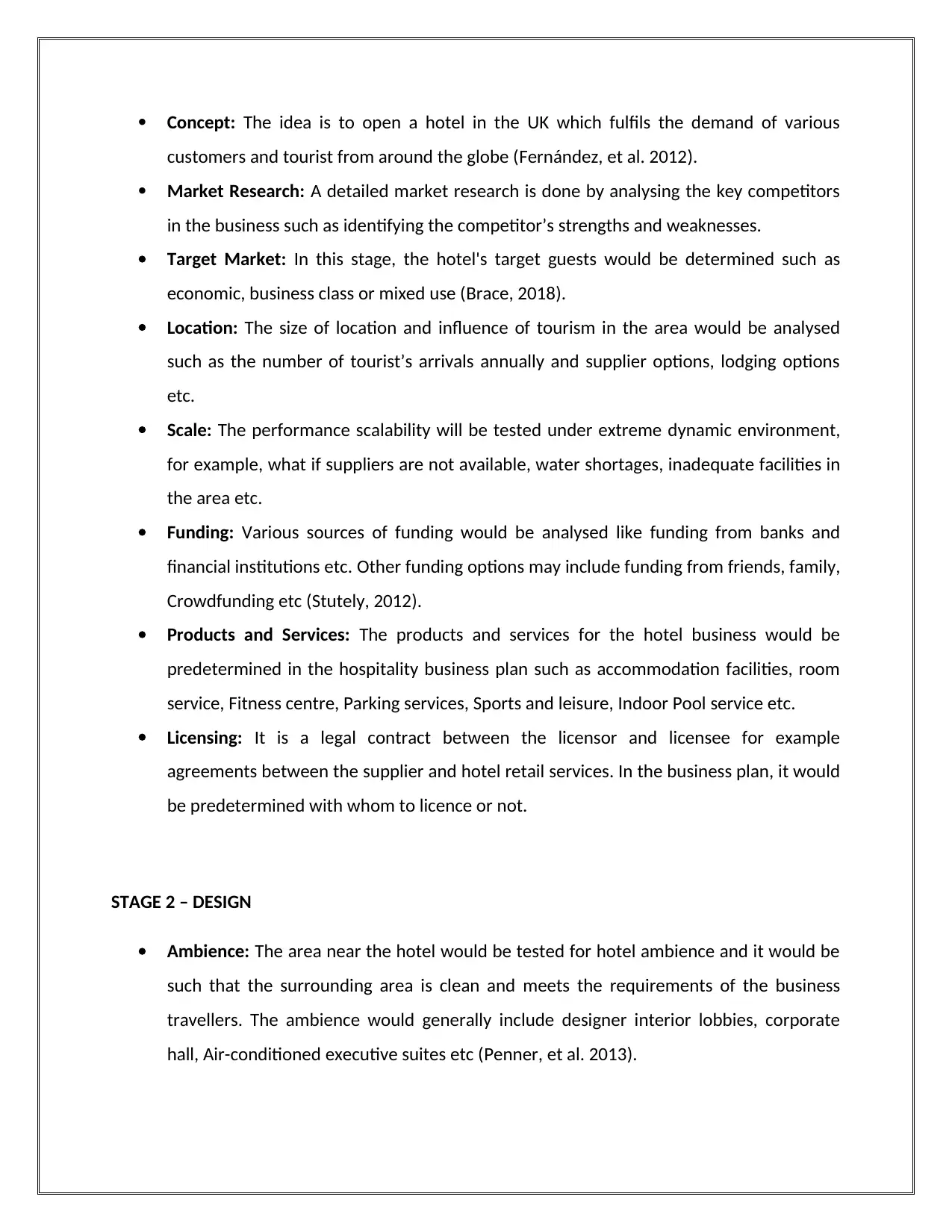
Concept: The idea is to open a hotel in the UK which fulfils the demand of various
customers and tourist from around the globe (Fernández, et al. 2012).
Market Research: A detailed market research is done by analysing the key competitors
in the business such as identifying the competitor’s strengths and weaknesses.
Target Market: In this stage, the hotel's target guests would be determined such as
economic, business class or mixed use (Brace, 2018).
Location: The size of location and influence of tourism in the area would be analysed
such as the number of tourist’s arrivals annually and supplier options, lodging options
etc.
Scale: The performance scalability will be tested under extreme dynamic environment,
for example, what if suppliers are not available, water shortages, inadequate facilities in
the area etc.
Funding: Various sources of funding would be analysed like funding from banks and
financial institutions etc. Other funding options may include funding from friends, family,
Crowdfunding etc (Stutely, 2012).
Products and Services: The products and services for the hotel business would be
predetermined in the hospitality business plan such as accommodation facilities, room
service, Fitness centre, Parking services, Sports and leisure, Indoor Pool service etc.
Licensing: It is a legal contract between the licensor and licensee for example
agreements between the supplier and hotel retail services. In the business plan, it would
be predetermined with whom to licence or not.
STAGE 2 – DESIGN
Ambience: The area near the hotel would be tested for hotel ambience and it would be
such that the surrounding area is clean and meets the requirements of the business
travellers. The ambience would generally include designer interior lobbies, corporate
hall, Air-conditioned executive suites etc (Penner, et al. 2013).
customers and tourist from around the globe (Fernández, et al. 2012).
Market Research: A detailed market research is done by analysing the key competitors
in the business such as identifying the competitor’s strengths and weaknesses.
Target Market: In this stage, the hotel's target guests would be determined such as
economic, business class or mixed use (Brace, 2018).
Location: The size of location and influence of tourism in the area would be analysed
such as the number of tourist’s arrivals annually and supplier options, lodging options
etc.
Scale: The performance scalability will be tested under extreme dynamic environment,
for example, what if suppliers are not available, water shortages, inadequate facilities in
the area etc.
Funding: Various sources of funding would be analysed like funding from banks and
financial institutions etc. Other funding options may include funding from friends, family,
Crowdfunding etc (Stutely, 2012).
Products and Services: The products and services for the hotel business would be
predetermined in the hospitality business plan such as accommodation facilities, room
service, Fitness centre, Parking services, Sports and leisure, Indoor Pool service etc.
Licensing: It is a legal contract between the licensor and licensee for example
agreements between the supplier and hotel retail services. In the business plan, it would
be predetermined with whom to licence or not.
STAGE 2 – DESIGN
Ambience: The area near the hotel would be tested for hotel ambience and it would be
such that the surrounding area is clean and meets the requirements of the business
travellers. The ambience would generally include designer interior lobbies, corporate
hall, Air-conditioned executive suites etc (Penner, et al. 2013).
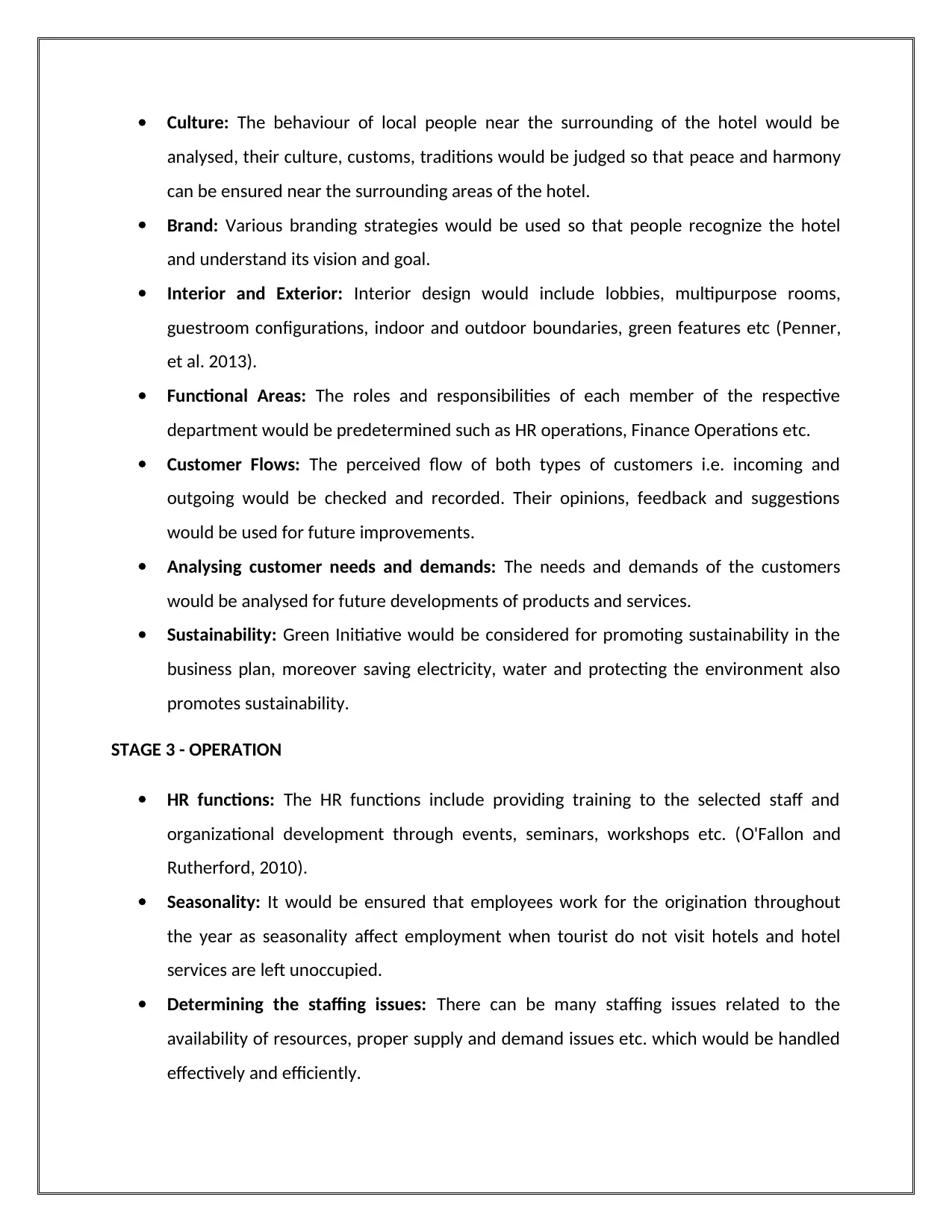
Culture: The behaviour of local people near the surrounding of the hotel would be
analysed, their culture, customs, traditions would be judged so that peace and harmony
can be ensured near the surrounding areas of the hotel.
Brand: Various branding strategies would be used so that people recognize the hotel
and understand its vision and goal.
Interior and Exterior: Interior design would include lobbies, multipurpose rooms,
guestroom configurations, indoor and outdoor boundaries, green features etc (Penner,
et al. 2013).
Functional Areas: The roles and responsibilities of each member of the respective
department would be predetermined such as HR operations, Finance Operations etc.
Customer Flows: The perceived flow of both types of customers i.e. incoming and
outgoing would be checked and recorded. Their opinions, feedback and suggestions
would be used for future improvements.
Analysing customer needs and demands: The needs and demands of the customers
would be analysed for future developments of products and services.
Sustainability: Green Initiative would be considered for promoting sustainability in the
business plan, moreover saving electricity, water and protecting the environment also
promotes sustainability.
STAGE 3 - OPERATION
HR functions: The HR functions include providing training to the selected staff and
organizational development through events, seminars, workshops etc. (O'Fallon and
Rutherford, 2010).
Seasonality: It would be ensured that employees work for the origination throughout
the year as seasonality affect employment when tourist do not visit hotels and hotel
services are left unoccupied.
Determining the staffing issues: There can be many staffing issues related to the
availability of resources, proper supply and demand issues etc. which would be handled
effectively and efficiently.
analysed, their culture, customs, traditions would be judged so that peace and harmony
can be ensured near the surrounding areas of the hotel.
Brand: Various branding strategies would be used so that people recognize the hotel
and understand its vision and goal.
Interior and Exterior: Interior design would include lobbies, multipurpose rooms,
guestroom configurations, indoor and outdoor boundaries, green features etc (Penner,
et al. 2013).
Functional Areas: The roles and responsibilities of each member of the respective
department would be predetermined such as HR operations, Finance Operations etc.
Customer Flows: The perceived flow of both types of customers i.e. incoming and
outgoing would be checked and recorded. Their opinions, feedback and suggestions
would be used for future improvements.
Analysing customer needs and demands: The needs and demands of the customers
would be analysed for future developments of products and services.
Sustainability: Green Initiative would be considered for promoting sustainability in the
business plan, moreover saving electricity, water and protecting the environment also
promotes sustainability.
STAGE 3 - OPERATION
HR functions: The HR functions include providing training to the selected staff and
organizational development through events, seminars, workshops etc. (O'Fallon and
Rutherford, 2010).
Seasonality: It would be ensured that employees work for the origination throughout
the year as seasonality affect employment when tourist do not visit hotels and hotel
services are left unoccupied.
Determining the staffing issues: There can be many staffing issues related to the
availability of resources, proper supply and demand issues etc. which would be handled
effectively and efficiently.
Paraphrase This Document
Need a fresh take? Get an instant paraphrase of this document with our AI Paraphraser

Policies and Procedures for recruitment and selection: Some policies, rules and
regulations would be implemented for the staff selected for operational activities. The
government rules and regulations relating to the hotel business would be followed so
that the business is free from any legal issues and compliances.
Promotional Activities: Sales and Marketing is an important aspect of any business for
long-term growth and success. Various advertisement campaigns, media involvement,
social media advertisement and many more promotional activities will be used for
promoting the company's product and services (O'Fallon and Rutherford, 2010).
Pricing Strategies: The pricing strategy accountability would be determined by local and
direct competitors and strategies would be formed for lowering the pricing of goods and
services.
regulations would be implemented for the staff selected for operational activities. The
government rules and regulations relating to the hotel business would be followed so
that the business is free from any legal issues and compliances.
Promotional Activities: Sales and Marketing is an important aspect of any business for
long-term growth and success. Various advertisement campaigns, media involvement,
social media advertisement and many more promotional activities will be used for
promoting the company's product and services (O'Fallon and Rutherford, 2010).
Pricing Strategies: The pricing strategy accountability would be determined by local and
direct competitors and strategies would be formed for lowering the pricing of goods and
services.
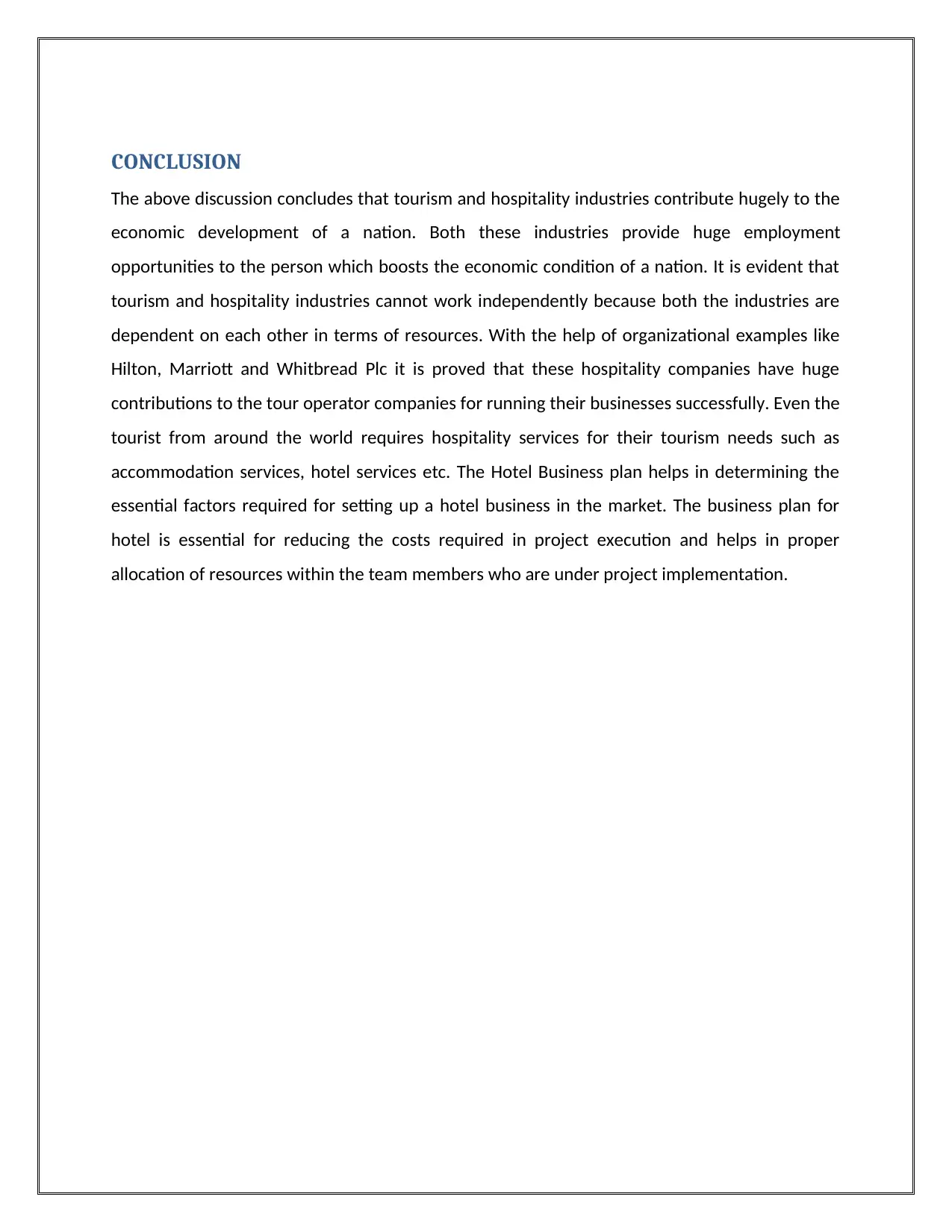
CONCLUSION
The above discussion concludes that tourism and hospitality industries contribute hugely to the
economic development of a nation. Both these industries provide huge employment
opportunities to the person which boosts the economic condition of a nation. It is evident that
tourism and hospitality industries cannot work independently because both the industries are
dependent on each other in terms of resources. With the help of organizational examples like
Hilton, Marriott and Whitbread Plc it is proved that these hospitality companies have huge
contributions to the tour operator companies for running their businesses successfully. Even the
tourist from around the world requires hospitality services for their tourism needs such as
accommodation services, hotel services etc. The Hotel Business plan helps in determining the
essential factors required for setting up a hotel business in the market. The business plan for
hotel is essential for reducing the costs required in project execution and helps in proper
allocation of resources within the team members who are under project implementation.
The above discussion concludes that tourism and hospitality industries contribute hugely to the
economic development of a nation. Both these industries provide huge employment
opportunities to the person which boosts the economic condition of a nation. It is evident that
tourism and hospitality industries cannot work independently because both the industries are
dependent on each other in terms of resources. With the help of organizational examples like
Hilton, Marriott and Whitbread Plc it is proved that these hospitality companies have huge
contributions to the tour operator companies for running their businesses successfully. Even the
tourist from around the world requires hospitality services for their tourism needs such as
accommodation services, hotel services etc. The Hotel Business plan helps in determining the
essential factors required for setting up a hotel business in the market. The business plan for
hotel is essential for reducing the costs required in project execution and helps in proper
allocation of resources within the team members who are under project implementation.
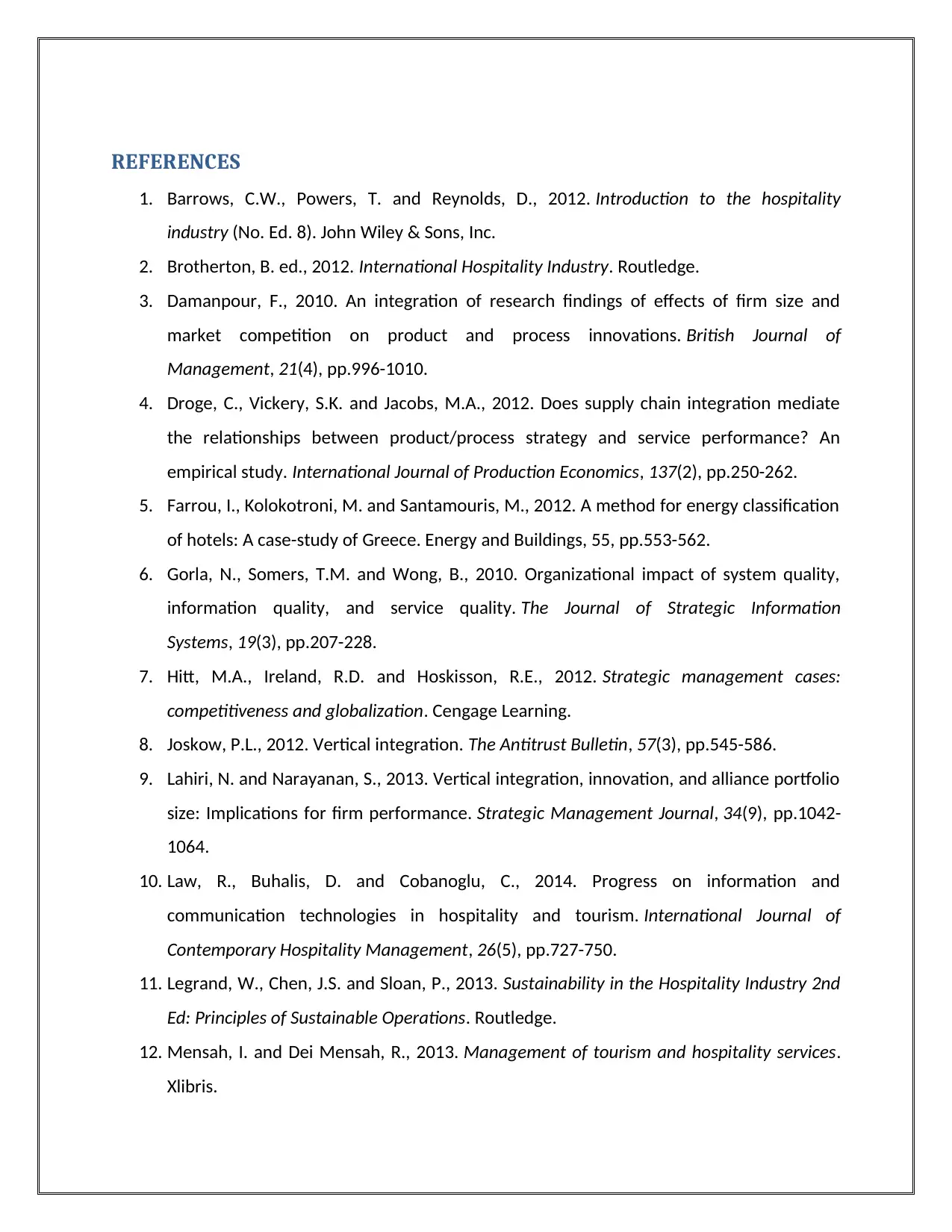
REFERENCES
1. Barrows, C.W., Powers, T. and Reynolds, D., 2012. Introduction to the hospitality
industry (No. Ed. 8). John Wiley & Sons, Inc.
2. Brotherton, B. ed., 2012. International Hospitality Industry. Routledge.
3. Damanpour, F., 2010. An integration of research findings of effects of firm size and
market competition on product and process innovations. British Journal of
Management, 21(4), pp.996-1010.
4. Droge, C., Vickery, S.K. and Jacobs, M.A., 2012. Does supply chain integration mediate
the relationships between product/process strategy and service performance? An
empirical study. International Journal of Production Economics, 137(2), pp.250-262.
5. Farrou, I., Kolokotroni, M. and Santamouris, M., 2012. A method for energy classification
of hotels: A case-study of Greece. Energy and Buildings, 55, pp.553-562.
6. Gorla, N., Somers, T.M. and Wong, B., 2010. Organizational impact of system quality,
information quality, and service quality. The Journal of Strategic Information
Systems, 19(3), pp.207-228.
7. Hitt, M.A., Ireland, R.D. and Hoskisson, R.E., 2012. Strategic management cases:
competitiveness and globalization. Cengage Learning.
8. Joskow, P.L., 2012. Vertical integration. The Antitrust Bulletin, 57(3), pp.545-586.
9. Lahiri, N. and Narayanan, S., 2013. Vertical integration, innovation, and alliance portfolio
size: Implications for firm performance. Strategic Management Journal, 34(9), pp.1042-
1064.
10. Law, R., Buhalis, D. and Cobanoglu, C., 2014. Progress on information and
communication technologies in hospitality and tourism. International Journal of
Contemporary Hospitality Management, 26(5), pp.727-750.
11. Legrand, W., Chen, J.S. and Sloan, P., 2013. Sustainability in the Hospitality Industry 2nd
Ed: Principles of Sustainable Operations. Routledge.
12. Mensah, I. and Dei Mensah, R., 2013. Management of tourism and hospitality services.
Xlibris.
1. Barrows, C.W., Powers, T. and Reynolds, D., 2012. Introduction to the hospitality
industry (No. Ed. 8). John Wiley & Sons, Inc.
2. Brotherton, B. ed., 2012. International Hospitality Industry. Routledge.
3. Damanpour, F., 2010. An integration of research findings of effects of firm size and
market competition on product and process innovations. British Journal of
Management, 21(4), pp.996-1010.
4. Droge, C., Vickery, S.K. and Jacobs, M.A., 2012. Does supply chain integration mediate
the relationships between product/process strategy and service performance? An
empirical study. International Journal of Production Economics, 137(2), pp.250-262.
5. Farrou, I., Kolokotroni, M. and Santamouris, M., 2012. A method for energy classification
of hotels: A case-study of Greece. Energy and Buildings, 55, pp.553-562.
6. Gorla, N., Somers, T.M. and Wong, B., 2010. Organizational impact of system quality,
information quality, and service quality. The Journal of Strategic Information
Systems, 19(3), pp.207-228.
7. Hitt, M.A., Ireland, R.D. and Hoskisson, R.E., 2012. Strategic management cases:
competitiveness and globalization. Cengage Learning.
8. Joskow, P.L., 2012. Vertical integration. The Antitrust Bulletin, 57(3), pp.545-586.
9. Lahiri, N. and Narayanan, S., 2013. Vertical integration, innovation, and alliance portfolio
size: Implications for firm performance. Strategic Management Journal, 34(9), pp.1042-
1064.
10. Law, R., Buhalis, D. and Cobanoglu, C., 2014. Progress on information and
communication technologies in hospitality and tourism. International Journal of
Contemporary Hospitality Management, 26(5), pp.727-750.
11. Legrand, W., Chen, J.S. and Sloan, P., 2013. Sustainability in the Hospitality Industry 2nd
Ed: Principles of Sustainable Operations. Routledge.
12. Mensah, I. and Dei Mensah, R., 2013. Management of tourism and hospitality services.
Xlibris.
Secure Best Marks with AI Grader
Need help grading? Try our AI Grader for instant feedback on your assignments.
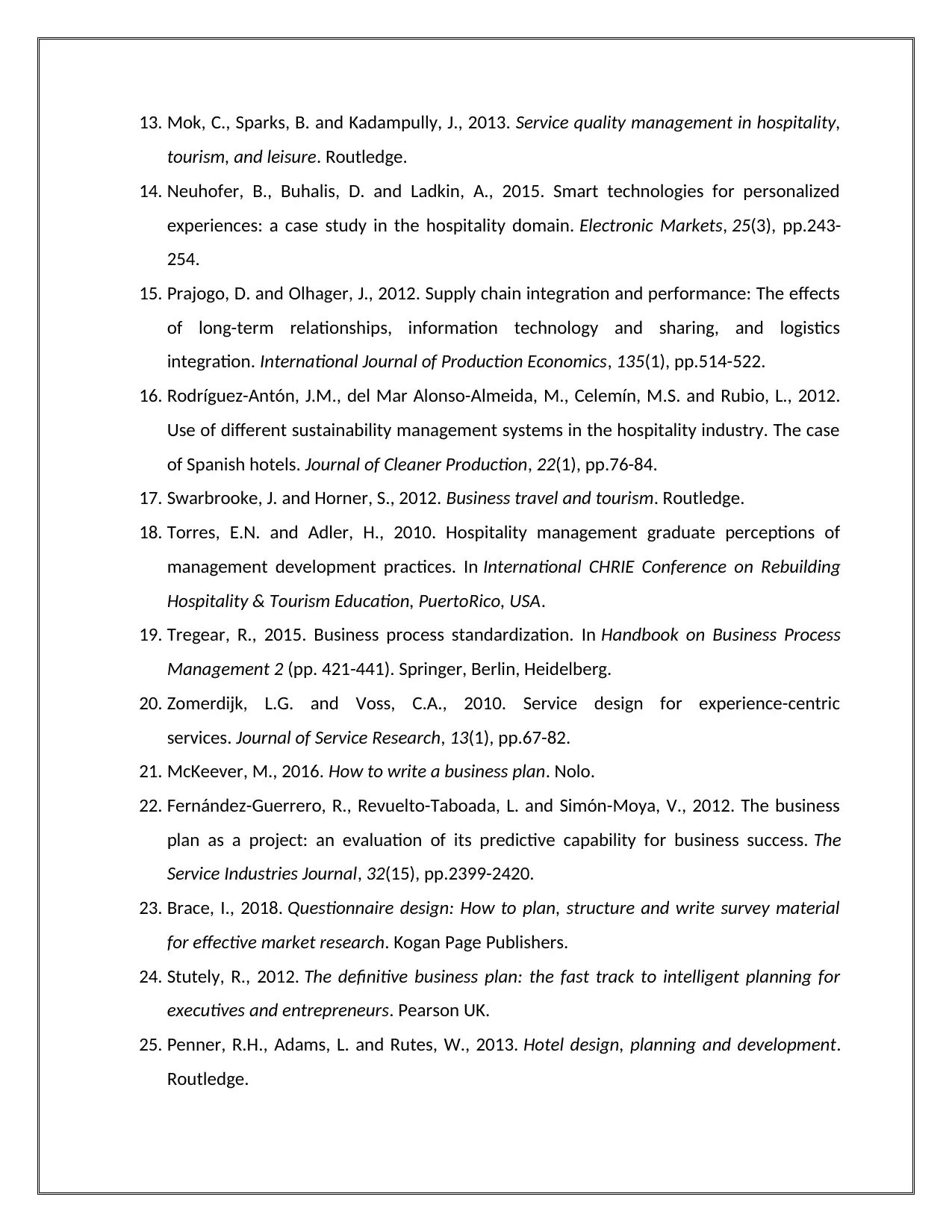
13. Mok, C., Sparks, B. and Kadampully, J., 2013. Service quality management in hospitality,
tourism, and leisure. Routledge.
14. Neuhofer, B., Buhalis, D. and Ladkin, A., 2015. Smart technologies for personalized
experiences: a case study in the hospitality domain. Electronic Markets, 25(3), pp.243-
254.
15. Prajogo, D. and Olhager, J., 2012. Supply chain integration and performance: The effects
of long-term relationships, information technology and sharing, and logistics
integration. International Journal of Production Economics, 135(1), pp.514-522.
16. Rodríguez-Antón, J.M., del Mar Alonso-Almeida, M., Celemín, M.S. and Rubio, L., 2012.
Use of different sustainability management systems in the hospitality industry. The case
of Spanish hotels. Journal of Cleaner Production, 22(1), pp.76-84.
17. Swarbrooke, J. and Horner, S., 2012. Business travel and tourism. Routledge.
18. Torres, E.N. and Adler, H., 2010. Hospitality management graduate perceptions of
management development practices. In International CHRIE Conference on Rebuilding
Hospitality & Tourism Education, PuertoRico, USA.
19. Tregear, R., 2015. Business process standardization. In Handbook on Business Process
Management 2 (pp. 421-441). Springer, Berlin, Heidelberg.
20. Zomerdijk, L.G. and Voss, C.A., 2010. Service design for experience-centric
services. Journal of Service Research, 13(1), pp.67-82.
21. McKeever, M., 2016. How to write a business plan. Nolo.
22. Fernández-Guerrero, R., Revuelto-Taboada, L. and Simón-Moya, V., 2012. The business
plan as a project: an evaluation of its predictive capability for business success. The
Service Industries Journal, 32(15), pp.2399-2420.
23. Brace, I., 2018. Questionnaire design: How to plan, structure and write survey material
for effective market research. Kogan Page Publishers.
24. Stutely, R., 2012. The definitive business plan: the fast track to intelligent planning for
executives and entrepreneurs. Pearson UK.
25. Penner, R.H., Adams, L. and Rutes, W., 2013. Hotel design, planning and development.
Routledge.
tourism, and leisure. Routledge.
14. Neuhofer, B., Buhalis, D. and Ladkin, A., 2015. Smart technologies for personalized
experiences: a case study in the hospitality domain. Electronic Markets, 25(3), pp.243-
254.
15. Prajogo, D. and Olhager, J., 2012. Supply chain integration and performance: The effects
of long-term relationships, information technology and sharing, and logistics
integration. International Journal of Production Economics, 135(1), pp.514-522.
16. Rodríguez-Antón, J.M., del Mar Alonso-Almeida, M., Celemín, M.S. and Rubio, L., 2012.
Use of different sustainability management systems in the hospitality industry. The case
of Spanish hotels. Journal of Cleaner Production, 22(1), pp.76-84.
17. Swarbrooke, J. and Horner, S., 2012. Business travel and tourism. Routledge.
18. Torres, E.N. and Adler, H., 2010. Hospitality management graduate perceptions of
management development practices. In International CHRIE Conference on Rebuilding
Hospitality & Tourism Education, PuertoRico, USA.
19. Tregear, R., 2015. Business process standardization. In Handbook on Business Process
Management 2 (pp. 421-441). Springer, Berlin, Heidelberg.
20. Zomerdijk, L.G. and Voss, C.A., 2010. Service design for experience-centric
services. Journal of Service Research, 13(1), pp.67-82.
21. McKeever, M., 2016. How to write a business plan. Nolo.
22. Fernández-Guerrero, R., Revuelto-Taboada, L. and Simón-Moya, V., 2012. The business
plan as a project: an evaluation of its predictive capability for business success. The
Service Industries Journal, 32(15), pp.2399-2420.
23. Brace, I., 2018. Questionnaire design: How to plan, structure and write survey material
for effective market research. Kogan Page Publishers.
24. Stutely, R., 2012. The definitive business plan: the fast track to intelligent planning for
executives and entrepreneurs. Pearson UK.
25. Penner, R.H., Adams, L. and Rutes, W., 2013. Hotel design, planning and development.
Routledge.
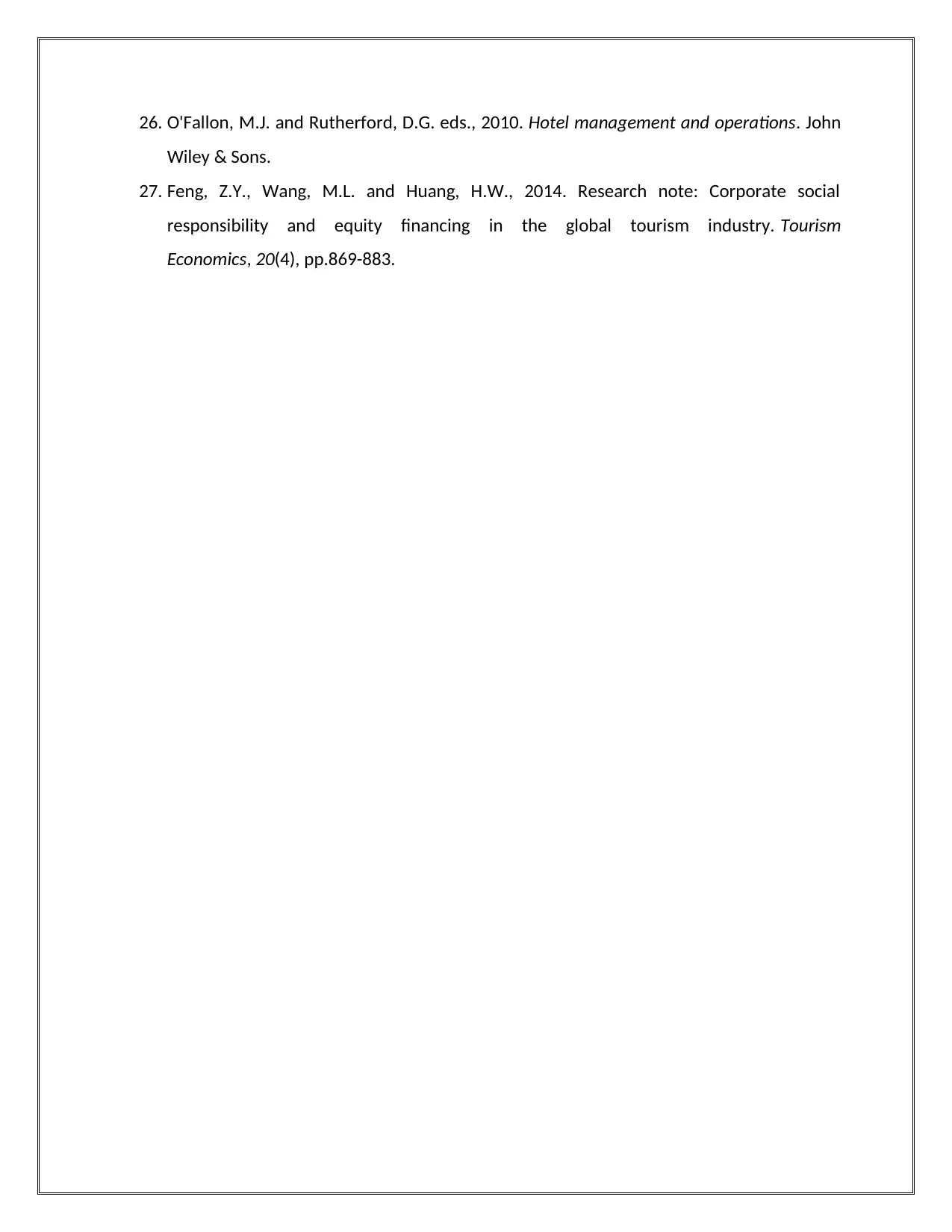
26. O'Fallon, M.J. and Rutherford, D.G. eds., 2010. Hotel management and operations. John
Wiley & Sons.
27. Feng, Z.Y., Wang, M.L. and Huang, H.W., 2014. Research note: Corporate social
responsibility and equity financing in the global tourism industry. Tourism
Economics, 20(4), pp.869-883.
Wiley & Sons.
27. Feng, Z.Y., Wang, M.L. and Huang, H.W., 2014. Research note: Corporate social
responsibility and equity financing in the global tourism industry. Tourism
Economics, 20(4), pp.869-883.
1 out of 24
Related Documents
Your All-in-One AI-Powered Toolkit for Academic Success.
+13062052269
info@desklib.com
Available 24*7 on WhatsApp / Email
![[object Object]](/_next/static/media/star-bottom.7253800d.svg)
Unlock your academic potential
© 2024 | Zucol Services PVT LTD | All rights reserved.





